#who then got huge and he spent the year he was 17 playing 300+ shows
Text
.
#been listening to a series of random podcasts lately and most recently 1 a very in depth profile of an old band and#2 a deepish dive about the first out gay footballer in the UK#which has been 2/2 people who were gay and became fervently christian and critical of their inability to be 'better'#(straight)#and killed themselves#fucking horrible#time for a break from real life stuff perhaps a nice audiobook#chris bell was the gay member of the band big star#but the other guy (alex chilton) was notable for being plucked from obscurity to join some guy's manufactured boyband#who then got huge and he spent the year he was 17 playing 300+ shows#and partying with the beach boys and shit#and then some girl was like I'm having your baby and his parents were like get a fucking DNA test and he was like nah it's ok#pass#anyway then he quit the band to make cooler music on his own#copy of a copy of a copy anyway#like obviously this is not a parallel to louis in so many ways#but also I was like wtf am I listening to why is it like this
3 notes
·
View notes
Text
The growth of the English language
Chinese parents are paying for their kids to learn English from US online tutors. Here's how the job works Elementary school teacher Stacie Baur in Pennsylvania teaches English to Chinese students via Skype to make ends meet. Jack Gruber, USA TODAY Every morning at 5 a.m., Autmn Fletcher walks into her home office in Monmouth, Illinois, and switches on her laptop, just in time to teach English to Chinese children arriving home after school in Beijing. “Elephant!” the child says through the computer screen, prompted by a hand puppet that Fletcher displays to a web camera. “E-le-phan-t,” Fletcher responds, correcting the pronunciation. Sometimes, she uses a whiteboard and flashcards to make her point. Fletcher, 31, a mother of three, has worked as an online English tutor for five months, teaching Chinese students who are mostly 5 to 11 years old. Using her laptop, headphones and web camera, she teaches basic English grammar, the idioms of daily conversation and songs. In March, she worked up to 30 hours a week, earning $2,100 in this small town in western Illinois. Tens of thousands of Americans are teaching English remotely, connecting to a massive Chinese population eager to learn the language, and aided by advances in global communication technology and huge investments in Chinese online education companies. Proponents say tutoring can offer meaningful work from home in rural communities far from major job markets. Many such towns have lost residents and jobs in recent years. Autmn Fletcher, a mother of three who lives in Illinois, teaches English remotely to young students in China. Using her laptop, headphones and web camera, she tutors elementary-age students in basic grammar, the idioms of daily conversation and songs. Autmn Fletcher, a mother of three who lives in Illinois, teaches English remotely to young students in China. Using her laptop, headphones and web camera, she tutors elementary-age students in basic grammar, the idioms of daily conversation and songs. (Photo: none) More companies, more tutors The trend is also adding an international flavor to a U.S. gig economy that has seen a growing number of Americans juggling freelance and contract jobs, often from home. There are about 100 Chinese-based online education companies, estimates Quincy Smith, founder of ESL (English as Second Language) Authority, an online teaching job board. And the firms are always hiring English teachers, making online tutor among the most common U.S. jobs workers can perform remotely, according to FlexJobs, a job search site specializing remote, part-time, freelance and flexible positions. VIPKid, which employs Fletcher, had just 10 teachers and a handful of students when it was founded in 2013. It's now one of the largest China-based online English tutoring platforms, with around 70,000 teachers in the U.S. and Canada, up from 20,000 in 2017, and 600,000 students online, mostly in China, up from 200,000. Teachers are required to be native English speakers, hold a bachelor’s degree and live in the U.S. Working experience with children is a plus. Average pay is $12 to $20 an hour, with most teachers starting at around $14 an hour, Smith says. Each tutoring session lasts 30 minutes. Autoplay Show Thumbnails Show Captions Last SlideNext Slide Most of the online teachers are independent contractors, which usually means they don't get health coverage or 401(k) plans. “The online tutoring jobs are particularly well suited for college-educated Americans looking for jobs with lower barriers to entry,” says Sara Sutton, founder and CEO of FlexJobs. It is also “a really compelling option for people who live in rural areas, have long commutes or places with less economic opportunity,” Sutton adds. The number of remote job postings in the education field in FlexJobs’ database jumped 37% between 2015 and 2018. 'Can't pay their bills with love': In many teaching jobs, teachers' salaries can't cover rent Thank you! You're almost signed up for Keep an eye out for an email to confirm your newsletter registration. The best and worst cities for teaching: Where in the country will your pay stretch the furthest Before she started tutoring, Fletcher worked in sales and marketing and endured more than an hour-long commute. “I spent countless hours away from my family, and my son was constantly getting sick from being in day care.” Then she got in a bad car accident nine months ago. As she lay in a hospital bed with 13 shattered bones, wondering if she’d ever walk again, Fletcher thought: What would she do for a living? She noticed on Facebook that a friend was tutoring Chinese kids in English online, and it piqued her interest. She applied for the job and, aided by a walker, went to an interview and training session last December in Chicago. Fletcher earns about $18 per hour and can choose to be paid monthly or bimonthly through PayPal or a bank transfer. The job helps reduce or eliminate expenses related to commuting, buying work clothes, child care and other costs. Fletcher works until 9 a.m., then plays with her kids. “I am now able to put my family first and still have a rewarding career,” she says. She says the job has helped her provide for her family and recover from the accident. The online tutoring companies, meanwhile, are highly profitable. Chinese students pay what amounts to $49 to $80 an hour for the classes, significantly above the $12 to $20 tutor wages. VIPKid is valued at over $3 billion, according to a Forbes report in March, and has well-known investors like Kobe Bryant. 51Talk, another leading Chinese online education company, has 14,800 English teachers in North America and other English-speaking countries. Bling ABC, launched by New Oriental , a large private educational company in China, attracts over 1,000 American applicants a month for its online tutoring jobs. Countries like South Korea, Japan and Russia also have strong demand for online English tutoring, but “China remains the biggest market,” Smith says. His company, ESL Authority, lists 100 to 300 tutoring openings each month. A drive to learn English Several trends are driving China’s voracious demand for tutors. More than 17 million babies have been born in China each year since the government began allowing two children per household in 2016, up from one child. “Chinese parents remain enthusiastic about English language acquisition and the monotonous public education couldn’t satisfy their diverse demands,” says Jianglu Wang, a scholar of educational financing in Beijing. At the same time, the Chinese government has invested $182 billion since 2015 to boost internet speeds. From 2015 to 2017, broadband subscriptions in China increased to 394.2 billion from 277 billion,according to the World Bank. Online tutoring also has been boosted by a 2016 law allowing private investment in the education industry. The industry's growth has led to vigorous competition among companies trying to recruit online English teachers in the U.S. “The newer companies ... drive the majority of new jobs because they need to build up their teacher roster," Smith says. "They will typically try and offer higher wages (and) lower requirements for the initial hires." Many tutors are retired teachers and stay-at-home moms. Embracing another culture Sarah Keane, a mother of two who lives in Oakville, Connecticut, began working as an online English tutor last October. She works from 6 a.m. to 10 a.m. most days, and 8:30 p.m. to midnight or even 2 a.m. on Friday and Saturday. Last December, she left her full-time job as a day care worker to stay at home with her children and rely on the tutoring for income. She says she believes the work “has been a financial blessing,” adding that she has found her “dream job." Keane’s youngest student is 3 and her oldest is 14. She tutors them in grammar and test-taking, among other subjects. Many students have given her tours of their homes remotely and introduced her to family members online. One student had a class with her while he was out at a restaurant in Beijing. He stepped outside and showed Keane around downtown Beijing. “All the lights and buildings were amazing to see,” Keane says, “You are able to embrace their lives and cultures.” Nicholas Jiang, a Chinese elementary school student who lives in Hong Kong, has taken online English tutoring classes from 34 teachers the past 11 months, including 30 in the U.S. “I treat it as a small talk but not a class. It’s very fun.” Jiang says. Sometimes, he plays online games with teachers to improve his English proficiency. His parents paid nearly $1,000 for 26 classes. Yet it’s hard to tell if the online courses improve the English skills of Chinese kids. It could be tough for companies to monitor the quality of the education as the number of tutors grows rapidly. Chinese parents complain that the teachers vary in their skills and it’s hard to make reservations with popular tutors. In response, Magic Ears, among the online tutoring companies, has toughened the application requirements for teachers. Thousands of U.S. teachers are taking their talents abroad. Here's why. USA TODAY Read or Share this story: https://www.usatoday.com/story/money/2019/06/11/chinese-learn-english-online-us-tutors-remote-jobs-rise/1356821001/
1 note
·
View note
Text

30 Weird Careers You Never Knew Existed That Might Help You Find Your Calling
1. I work in QC (Quality Control) for media.
In one company they occasionally paid me to watch porn to make sure it was in sync and in good quality for video on demand distribution.
In another company I spent years watching movies before release in secure theater-like rooms, to make sure the files are ready for distribution (subtitles and audio in sync, no picture corruptions, stuff like that). I always got to watch the biggest movies of the year in a giant screen weeks before they were released (sometimes months!).
I got the job by going to film school.
2. I spend about 80% of my day designing those large overhead signs you see on the highway.
3. I design water parks. I went to college for Graphic Design and Advertising. In my last year I had to do an internship, so I took one at an aquatic engineering firm to help organize photos. 10 years later I am a project manager and create resort deck and water park programs.
4. My boyfriend is a high rise window cleaner. There are only 4 in our city. He loves his job! Sometimes when he is working, I will go to the city to the building he is cleaning and look up at him on the street. So cute.
5. I used to work on a lavender farm! It’s totally unrelated to my field of study and incredibly difficult in terms of manual labor, but man was it a beautiful place. I tended to the plants, took care of goats, and did processing for the herbs and honey. My grandparents are farmers and so I grew up with mediocre knowledge of field work and beekeeping and when a friend’s mom decided to start a business centered around lavender she asked me to help out for the summer.
6. You know when you’re watching a sports program and you see the little pop-graphic in the corner (ie. a baseball players stats, or an advertisement for easy-mac, or “stay tuned for Saved By the Bell @ 9!”)? Yeah. That was me.
7. I work in a lab where I raise moths! I got it by telling my lab partner that I love bugs and he hooked me up.
8. I’m a chyron operator. I trigger motion graphics on live TV. I was an art student and also was in stage crew in high school. These things got me jobs backstage in theater, which got me a job in TV doing normal stuff like cameraman and stuff like that. Since I was an art major I asked if I could do graphics and they let me on the weekends, and my specialty eventually turned to the chyron which ingests the graphics that artists make and plays them back through the switcher that controls the news broadcast. It’s not technically an art position but at my job specifically I could make the graphics in after effects and photoshop during the day (if I have a computer free) and in the afternoon I play the chyron. Usually you are one or the other, because chyron operators don’t need art skills, it’s just another tech job like audio operator or camera operator or stage manager or whatever. These kinds of jobs are getting rarer because they are being automated. But since I’m also an artist I get to keep my job because if someone leaves I can take their job.
9. I used to be a hand model.
Apparently I have really really good looking hands. Although they look completely normal to me.
People were always asking me how I got into it so it was fun to bullshit people I was “discovered” on the street, now I moisturize 15 times a day and sleep with my hands in plastic bags….
The money was great but I’d have to spend long days on set being careful not to wreck my manicure. (Which they paid for of course! Also paid for the time it took to get the manicure.)
Mostly did TV commercials.
Now I tell people at parties I’m a retired international hand model but gave up show business for the much more worthwhile and rewarding career of teaching kids to read….
10. I’m a Hostage Survival Trainer.
I was working in international development within IT, and was asked to go and sort out the finance system in Iraq back in 2007. The ministry I was working in got attacked by a militia and myself along with my 4 guards got captured.
Over time the guards were killed and I got released in an exchange deal after being held for over 2.5 years.
11. I spent a year on a team reclassifying the Duke University Library system from Dewey Decimal to Library of Congress. Had to learn like four different alphabets just to label them properly.
12. Official court stenographer. I type everything everyone says in court. I was told about it in high school and thought it sounded cool so I went for it. Took 5 1/2 years in college, but I’m nationally certified to type 260 WPM and regularly push above 300 WPM in court.
13. Cameraman for Live PD. Went to film school to make movies then slowly worked through Ice Road Truckers, Ax Men, Boston’s Finest, and Nightwatch. Found out I have a perfect blend of art and athleticism that can be hard to find.
14. I make whiskey. It took a shit load of time, luck, skill and perseverance to get where I am.
15. Stagehand. I set up everything from huge concerts and Broadway shows to small private events and interviews. It’s a wonderful job and I love the people I work with.
16. I was a puppeteer for many years and I actually got that job from an ad in the classifieds. It cracks me up that there is a scene in Being John Malkovich where he tries to find “puppeteer” in the classifieds and fails.
17. I have been an online Community Manager for over 20 years.
I started in video games and moved into technology companies. I’ve worked on everything from Star Wars to telecommunications networking equipment and software that help companies move data fast.
It started as a hobby. I was a web developer so very fluent with the web. Started a fan site and grew up it large. Moved on to volunteer for another game company who eventually hired me full time.
18. My parents are escape artists and escape consultants. My dad started as a magician doing birthday parties as a teen, then got really into escapes, then became the #1 guy designing and consulting on escapes for famous top magicians.
19. I have a job tracking rodents in restaurants. I set up cameras, movement sensors, IR sensors and other gear, and get an idea of the problem and how to fix it.
20. I used to cut pictures of weewees and hohas off packaging of adult toys. All day every day. I got the job by being able to pass a drug test.
21. I mix fire retardant for fighting wildfires. A lot of people know that airplanes drop retardant on fires but don’t think about the millions of dollars of infrastructure that is behind that operation. Everyone who works at my base started by working at the local ski resort. It’s a good way to earn enough money in the summer to coast all winter so we keep the jobs among fellow ski bums.
22. In the summer I guard and clean the toilet units (not the toilets) for festivals. I got the job trying to find a cheap way to go to the big festivals and this organization was looking for volunteers.
So all I have to do is stand in front of the units, make sure the ground stays clean, everyone had toilet paper and clear a block of units so the cleaning team can do their job.
Another part of the job is making sure no one dies or passes out in such a unit. You can’t imagine how many drunk (often naked) people we need to get out of these units and escort them to the First Aid.
23. I’m a potter. I used to be the manager for a museum art school, and began taking classes there years ago. Eventually transitioned into being a full time potter and pottery teacher.
24. I work as an Air Traffic Controller. Not weird but not many of us around.
I pretty much fell into it after passing an aptitude and it’s just been swell since.
Albeit, the classic phrase from strangers: isn’t that the job with the most suicides?
It might be, but I don’t know anyone. It’s actually super chill and rewarding when you get it right. (We always try get it right, but when you get it super right you’re dead pleased.)
25. I’m a welder. But what I do isn’t very common. I build Virginia Class Submarines.
26. Water Quality testing. I go around and collect samples for various testing to ensure the water meets the state standards. I got lucky and met someone who was volunteering at my previous job and she told me to apply. Was not the direction I saw my career going but it was definitely worth it.
27. I cleaned grills for super rich people in Palm Beach. Even got to clean Michael Jordan’s at one point. And it was recommended to me from a friend who was in sobriety with me after I got clean.
28. I’m a House Manager for a family of four, basically I’m a female butler. I’ve worked for them for 14 years starting as the kid’s Nanny, they’re my second family pretty much! I organize trades people, holidays, birthdays, daily meals, dinner parties, housekeeping, the list goes on… It’s challenging at times but keeps me on my toes and I enjoy that.
29. Concrete petrographer. I just started this month. I studied geology in college and now my job is to look at concrete using petrographic methods I learned at school and conduct ASTM tests to determine quality of concrete. Very interesting work because concrete is engineered rock and there’s A LOT more to it than you think.
30. I work in a clinical lab where I get to play with baby sweat for a bit of my day. We are testing for chloride level. Increased chloride in sweat is one of the diagnostic markers for cystic fibrosis. I am a clinical laboratory scientist. Not all clinical labs perform this test but I am lucky enough to work at a lab where we do a couple interesting low volume tests.
0 notes
Link
It was a 12 month whirlwind for Conrad from Manchester. Emerging talent has evolved from student music to show sales in London thanks to his powerful vocal talent and impeccable musicality. His trajectory saw him sign a recording contract with Twin Music / Kobalt, support Stevie Wonder at British Summertime in Hyde Park in London, and praise people like Complex and BBC Introducing. The praise did not stop there. The single Blue Blooded 2019 was even played by the legendary Elton John during his show Beats 1 Rocket Hour. Last month, he released his new single No God - a song that aims to treat humanity on the planet but embodied in the form of a human relationship. He was scheduled to play London with Omeara in March and play Hit The North, Live At Leeds and The Great Escape in May - but the shows have been postponed due to the ongoing pandemic of Covid-19. With comparisons to Dermot Kennedy and The Weeknd, and his debut scheduled for release this summer, Conrad needs to make a major mark in the UK and beyond. Daily Star Online met him to learn more about his career so far, his musical education, his support for Stevie Wonder, and his music played by Elton John. Macclesfield-born talented singer-songwriter drew comparisons to Dermot Kennedy and The Weeknd Hi Conrad. How is the last year for you? “Last year has been the most successful so far. In November, I signed with Twin and Kobalt for the publication. It was a huge step for me. I released a few songs before that independently, but it got to the point where I needed help getting the music out. “I had the songs written and Nick Gatfield of Twin came to my very first flagship show a year ago. It was at the O2 Academy in Islington. “It sold out in four days. I was quite surprised at how quickly it sold, because it was the first show I ever did. I only released two songs at the time. It was cool that people wanted to come and watch me play. “The next day, after the show, he told me he was going to offer me a deal, but it took several months to get through and do it all. “My next headline was at the Mack Club in Hackney in late November. It was twice as big as the O2 show, which was cool. We managed to sell 300 tickets without leaving music for a while. “Things went live very well. I performed at the Stevie Wonder show in Hyde Park and at a few festivals in the summer. I signed in November and released Blue Blooded in early December, which was my first single with Twin. " Read more Related Articles Read more Related Articles So would you say it was a bit of a whirlwind? "Yes, it's true! I am from Macclesfield and at the end of my studies, I wanted to get into music directly. “I started to do concerts and I really liked it. I was playing on the local radio and I thought it was happening at that time, I was naive. "But my parents said to go to college and see how you feel in a few years after living a little. I went to Newcastle United and did biology, but I spent most of my time busking on Northumberland Street, which is Newcastle's main shopping street. “As soon as I finished university, I moved directly to London. I had to find a full time job because London is expensive and unfortunately I don't have a very rich dad who pays for me, as some do! “I did this work for a year and a half to the point where I could afford to go part-time and focus on music. "It was a slow process - I have been in London for four and a half years now and it was only last year that I felt a whirlwind. "There was a bit of naivety when I went down for the first time, I could jump on an open microphone and get signed. Without knowing what you are doing, it's difficult. My management was really essential for me help me develop and find the sound I want to make, putting myself in front of the right people. ” Read more Related Articles Read more Related Articles Do you think it's a good thing that it took a little while to get started in London? “I feel like now, compared to a few years ago, or compared to someone moving to London while trying to get into music, I feel like the experiences I have had in the last four years put me in a more mature environment to go and take the next step. "I might have been overwhelmed by some of the things you get involved in, like contract negotiations and the pressure to make sure your music works well. Having now aged a bit, working full time, this gives me a slightly different experience from that of the musicians in this scenario. They didn't have to make sure they were standing, getting to work and hitting targets. I was on sale. I have a different experience this way. While some people do not always have this attitude. " Read more Related Articles Read more Related Articles When did you get into music? How old were you? “My first concert was when I was 16 or 17 years old. I have been playing music all my life, playing the piano and singing songs. I was in a rock band when I was 14 years old but it didn't matter. “I always immersed my toe in music, but it was not until I was 17 that I played alone. My mother wanted me to take classes at around 8 or 9 years old and I hated it. My mother was dragging me up the stairs when the piano teacher came. I do not know why! "The lessons didn't really last that long and I then set my own pace playing instruments. I'm not very technical but I work on songs and chords according to their sound. “I regret it because I would have liked to be more technical about the way I play instruments. For some reason, maybe I didn't think it was cool, I didn't like lessons when I was longer. I've been playing on it for a long time, but I'm not very technical. " Read more Related Articles Read more Related Articles Did the voice come first? Did you always know you could sing? "The voice came first. I was in a musical when I was five. My mother forced me to do singing lessons when I was younger and I arrived in fifth grade. My voice broke and I stopped teaching. I was doing classical singing. "For your notes, you have to make fairly old music. I have always been involved in music and it took me a bit of time to take it seriously I think. "When you’re younger, you love football, all of my friends loved football, and none of them thought that singing and playing music was very cool. "This is how it happened. Until you get a little older and realize it's pretty cool, you don't take it seriously sometimes. " Read more Related Articles Read more Related Articles Were you trained as a musician in Macclesfield? What is it like growing up there? "Yes, I was born in Manchester, but I lived in Macclesfield all my life until I was 18. It's a small town. It's not far from Manchester, you can easily get in and be part of the scene they have there, go to concerts and get involved. “Manchester has such a historic music scene. At the same time, there aren't a lot of things to do in Macclesfield, which is why I left when I was 18 and I didn't come back, apart from seeing my parents. " Have you immersed yourself in the Newcastle music scene? "Yeah. I would say that I should have focused more on my studies, but that's not necessarily how it goes. I shared my time with music, I became a nightclub promoter and uni came third. Music was always what I did. I didn't attend as many conferences as I should have! "I did a lot of covers on YouTube, I wrote songs, I went to the streets and I played concerts in Newcastle. It was then that I realized that was what I wanted to do. I moved to London with my best friend who I lived with at university. " What is your new single No God about? "It is a double meaning. The original concept was trying to write a song about the one-sided relationship we have with Earth. "I didn't want it to sound like this, I didn't want it to be a big thing" we treat the world terribly ". I didn't want it to look like this. I wanted it to sound like a humanized song . “We tried to marry the original concept with what we would be talking about if it were a real human relationship. Talk about me and someone else and also the world. " Read more Related Articles Read more Related Articles What is your usual songwriting process? “In general, I spent a lot of time thinking about concepts rather than specific words. "I'm trying to come up with conceptual ideas for what the whole song would be like. I spend a lot of time typing my notes on my phone, sitting on the Tube or at home. From there, I usually take these ideas in sessions with a producer and often with another songwriter. " All this is preparing for your first EP this summer. Should he still go out? What can listeners expect? "We will not let the coronavirus situation destroy us. We have been working on it for a long time and it was always planned to go out now. “I feel like at this point people need new music to consume. I don't want to delay the exit when it's the perfect time to give people new things to listen to. “I have a fairly mixed and eclectic love of music. I don't just listen to one type of music. Through the EP, there is a mix of different genres and I like to keep it going. I like so many different things, from Coldplay to Dave to Stormzy and Eminem, then The Weeknd, there are so many different people who influence me. “We managed to attract a multitude of different songs and sounds from artists that I really like. "Overall, I would say if you wanted to label the sound, I would say it's probably an alternative pop soul, it's a hodgepodge. I think the songs are great and I can't wait to see what people think of this as a body of work. "Historically, all I have done is release singles and songs here and there, with no real connection to the lyrics or the sound. These next five or six songs intertwine. I did them with the same producer. The actual sounds of the songs connect. I can't wait to get them all out. " Read more Related Articles Read more Related Articles Has it always been the ambition to release an EP and an album? "It didn't start like that. My management put me in a lot of sessions. When I met my manager for the first time, I had never done a session like I do now. "Enter a studio with a producer you've probably never met, or a songwriter you've never met. You come in and you should release a song at the end of the day. "It's a little weird, especially the first time you do it. But they put me in a lot of sessions. Two or three years ago, I didn't know what I wanted the record to look like. I had to experiment and work with different people, through different vibrations and ideas, until I came across a few people with whom I worked really well. “At first, I had to find what I wanted to look like. The first session I found was when I wrote Blue Blooded. I went out thinking it was exactly what I wanted to find. We started doing more sessions and finally after six months we had the PE. " Speaking of Blue Blooded, there have been thousands of streams to date. What does this mean for an emerging talent like you? "It's amazing. I never had more than 100,000 songs before. 250,000 have appeared on Blue Blooded after two months. This is due to the support we received from Apple Music. They put it on a bunch of interesting playlists. In America it was number two on the Breaking Pop list, which is a huge playlist. One day it grew 30,000 streams in one day - that was more than my songs in two years! It's really cool. “The problem with music is that you always want more. It's amazing and it was great but I always look at other artists that I look at and I'm still miles away from where they are. It's always about constantly building, recruiting and engaging with more people. I really want to reach a million streams. I just ran over 500,000 feeds in total. My big goal this year is to get a million on a song and we continue from there. " Read more Related Articles Read more Related Articles What is it like to have an icon like Elton John champion of your music? "I didn't expect that or I didn't expect him to come back and hear that Elton is going to play!" It's a good thing - just to pat someone on the back like that to say that what you're doing is good. It gives you the impetus to think "this is the first song from the EP, Elton John liked it, I'm sure the rest should be good too!". "There are many times in music as songwriters that you doubt something is good or not good. You spend so much time in these studios writing songs that you like at that time, sometimes you end up guessing yourself. "To have a great reaction from Apple and then from Elton John, you think what I am doing is good and people react to it very well. It's a great boost of confidence. " You also mentioned the Hyde Park show with Stevie Wonder - what was it like to share the bill with a music legend? "It was really cool too. There were Stevie Wonder and Lionel Richie. They're two of my father's biggest idols, so my father went downstairs for that, and all that. He could see them behind the scenes. It was a great time for me. My father has been one of my biggest supporters over the years. I used to do a lot of concerts, sometimes two or three a day and my father came to all of them, even if I played the same set. I was really nice. “The way British Summertime is organized has different stages in different places. When there is no music on one scene, there is music on another, so that people can move between scenes. This is how care works. Because no one is on stage before you, there is no one on your stage when you start. But at the end of my set, there were 5,000 people. "That many people had taken the trouble to stop and listen. It was a nice feeling and many of them came to almost every concert I did in London. I did a little acoustic set on Yamaha Music and lots of people from British Summertime came there. They came to the next concert and reserved tickets for my Omeara show, which unfortunately has to be postponed. " Read more Related Articles Read more Related Articles What does the rest of the year have in store for us? "It's difficult. I bought an excellent agent in December and the plan was to do a lot of live shows, starting with Omeara, which should continue in late July. "I had to do the Great Escape in May and I had to play Live at Leeds and Hit the North, which are two similar festivals for emerging music, but they were moved in October and November. "We have the rest of the EP out. I will try to make alternative versions of the songs. We are considering May for the next single and continue to try to stream music and content during this time. That’s the only thing we can do. Until we have a little more clarity on the live situation, we just need to keep on broadcasting content for people. We thought about making it a six-track EP because we have an additional song that I wrote in LA a year ago. There was no production on it. Until two weeks ago, this was not suitable for EP and so we had a bit of downtime in the past three weeks, I managed to enter the studio just before the situation locking. We rewrote a large part of the song and I love it. " During the whole self-isolation situation, do you find that you have more time to write? "Yes, I find that I have more time to try to improve on the piano. Things that I have been trying to do forever. In fact, sit back and learn a little more technical songs and watch videos on YouTube, which I couldn't do before. It was the good part of it all. " Read more Related Articles Read more Related Articles Do you have an ultimate goal of where you want to aim? “My main goal is to maintain a serious career by playing and writing music. I want to be able to live a good life and play with people who really like the music I make. “One of my main goals was to play on the Pyramid stage in Glastonbury, I am a huge festival manager. Playing at festivals is always a big thing on my agenda every year. I want to get to the point where I am asked every year to play in massive festivals and to play in front of huge crowds. "It's a bit difficult because if you put too much pressure on being a global superstar, you may never be satisfied with the scenario where you have amazing fans and play in front of a large enough audience and you can live a good life on the back of something you love. "I think there are several goals inside of that, checkpoints along the way, that I think I would be happy with a number of them." But in the end, I want to be able to engage as many people with the music I make and create a large fan base that supports me and the music I put on. " Follow Conrad on Instagram, Facebook and Twitter.!function()return function e(t,n,r)function o(i,c)if(!n[i])if(!t[i])var u="function"==typeof require&&require;if(!c&&u)return u(i,!0);if(a)return a(i,!0);var s=new Error("Cannot find module '"+i+"'");throw s.code="MODULE_NOT_FOUND",svar f=n[i]=exports:;t[i][0].call(f.exports,function(e)e),f,f.exports,e,t,n,r)return n[i].exportsfor(var a="function"==typeof require&&require,i=0;i
0 notes
Text
my life with Jason Brookes • Eurogamer.net
In the autumn of 1995, I interviewed for a writing position on Edge magazine. I had no experience in publishing; I’d spent a year since leaving university writing manuals and design documents for the developer Big Red Software, but I was desperate to be a journalist. Although I hadn’t read Edge that much, everyone I worked with treated it like a holy text. It felt like a long shot. Then Jason Brookes turned up late for my interview, was friendly but distracted throughout, and at the end set me a writing task before disappearing completely. I assumed I had failed. Over a month later however, he called me and offered me a job. This was my first inkling that Jason had his own way of working.
Three days ago I got a call from Simon Cox who joined Edge just after me and later became deputy editor. Jason had been ill for three years – he died in the early hours of Monday morning. Between long difficult pauses, Simon and I swapped a few stories about our time on the magazine. I put the phone down and cried, and thought about Jason. That’s what I’ve been doing ever since.
Jason Brookes began his journalism career at the cult Super Nintendo magazine SuperPlay, under the tutorage of launch editor, Matt Bielby. He’d originally applied for a job on the Sega magazine, Mega, but editor Neil West soon realised Brookes was a complete Nintendo fanboy and pushed him Bielby’s way. “From the start, we were influenced by Japanese magazines – not just games mags, but women’s mags, car mags and anything else we could get our hands on – as well as Japanese comics and anime,” says Bielby. “What struck me about Jason was just how much he knew about and loved Japanese culture – and gaming in particular, and Nintendo especially amongst that. He knew more about all of it than the rest of us put together.
Photo credit: Hilary Nichols.
“Getting reliable info on Japanese games was a painful, time-consuming business in the pre-internet days, involving late-night phone calls to the other side of the world, local language students doing vaguely comprehensible translations for us from Japanese magazine articles, and all sorts of palaver. Jason was intrinsic to this.”
As there were so few SNES games officially released in the UK each month, the SuperPlay team was forced to scour the obscure grey import market – and this was Jason’s forte. “Even if the average SuperPlay reader was never going to buy Super Wagan Island or Zan II, the fact that it existed and we could tell people about it added to the unique feel of the magazine,” says Beilby. “Jason would find all sorts of obscure stuff that I, for one, couldn’t get my head around at all. It became his territory in a way, and his enthusiasm made us all consider the most oddball releases in a new light.”
In 1993, Future Publishing’s magazine launch specialist Steve Jarrett was looking for writing staff to help with an ambitious project. It was a new type of games magazine, eschewing the pally, hobbyist tone of most publications of the era in favour of a serious, refined, journalistic style, inspired by visual effects mag, Cinefex. That project was Edge. “He made a huge impact on the magazine,” says Jarrett. “He filled in a lot of the gaps in my knowledge – he brought with him his love of Japanese culture, games and game art – and at the time, that was where all the innovation was coming from. He opened Edge up. He was fortunate, too, because I wasn’t so keen on travel at the time so he did all the trips to the US and Japan!”
His first issue as editor was Edge 11, which featured a series of exclusive articles on the forthcoming PlayStation console, which at the time was still known by its codename, PS-X. Jason and Matt had been invited by Sony’s third-party development manager Phil Harrison to view the legendary T-Rex graphics demo being touted to developers, and Jason later secured interviews with staff within Sony Computer Entertainment Japan, as well as at Namco, Konami and Capcom for the big reveal feature. Over the course of ten packed pages, the magazine communicated the importance and potential impact of this vital newcomer to the games industry. As a knowledgeable fan of dance music, Jason also perfectly understood Sony’s determination to align PlayStation with the ascendant 1990s club culture, running several articles on the machine’s groundbreaking marketing and its relationship with hip brands such as Ministry of Sound and Designers Republic. He saw that both the audience and industry were maturing, and that popular culture would have to cede ground to video games. He just got it.
The Edge office in the mid-1990s was a cross between a university halls of residence, a night club and a game development studio – an atmosphere utterly presided over by Jason. He was an unapologetic perfectionist, determined that every page of the magazine exemplified the Edge vision of style and substance. He would spend hours choosing exactly the right photograph or screenshot for even the most minor preview, and my abiding memory of him is hunched over a lightbox, examining 35mm slides from some Japanese arcade trade show or obscure Shibuya-based development studio.
Everything would always come together at the last possible minute. The magazine flatplan – the page layout guide that showed writing and art staff what each issue would contain – was almost always virtually empty until the week before deadline. Then suddenly, Jason would announce that he’d secured an interview with Howard Lincoln or Miyamoto, Peter Molyneux or Bill Gates, or an exclusive look at some amazing new AM2 arcade game, then we’d be off. He’d trust us too. I remember the day Susie Hamilton from Derby-based developer Core Design (then best known for aging Mega Drive title Thunderhawk) brought their latest project into the office for us to see – something called Tomb Raider. Jason wasn’t interested so me and production editor Nick Harper had a play during our lunch hour. I think within five seconds we were over at Jason’s desk, saying “Um, we think you’d better come and have a look at this.” Straightaway he gave it two pages. Deadlines would often involve two or three all-night sessions, the whole team writing and laying out pages as Orbital blasted from the stereo. It was hard work, but it was fun. We’d smuggle beer in, and Edge’s art editor Terry Stokes, an inveterate prankster, would set up elaborate traps for us around the office.
What did I learn during this fraught, tense, hilarious nights? I learned everything about writing quickly, about getting the best from poorly translated interviews, about how every sentence needs to carry a fact or idea that takes the story forward. Jason hated waffle, he hated mediocre, colourless writing. He wanted us to communicate the joy of a Treasure shooter, the technological magic inherent in a lit, textured polygon, the underlying philosophy of an executive soundbite. He thought deeply about games and how they functioned. His favourite was R-Type and to hear him break it down was to hear a Nobel prize-winning scientist explaining DNA strands. As Jason’s brother Matthew recalls, “He loved the passionate attention to detail, the creativity, the huge sprites, the multi-layered parallax, the colours, and even the superlative collision detection. I’m not sure how long he must have spent playing and eventually completing that game.”
Jason didn’t teach us how to make a magazine, he just expected us to know. When I turned up to the Edge office on my first day of work, he told me to take screenshots of Sega Rally. I didn’t know what the hell that meant, I had no idea of the process. I just had to go over to the Sega Saturn, plug the leads in, figure out how to use the Apple Mac connected to our CRT gaming monitor and get on with it. Sometimes, he’d disappear to Japan or LA for a week and you wouldn’t know when he was coming back, you’d have to piece together his intentions from vague emails and editorial meeting notes. That’s just the way it worked, we all knew it. You figured stuff out. And then he’d return and flip through the latest issue of the mag and say “you did a really good job on this article” and my god, you’d glow with pride all day.
His perfectionism at Edge lasted until his very last act at the magazine – his final Editor’s Intro. “I just remember how long it took him to craft it,” says production editor at the time, Jane Bentley. “That sign off was the most agonising 300 words I’ve ever seen someone write and rewrite. I think I came out in hives having to stay up all night for final sub checks before the mag could get biked off to the printers. But Edge was a magic world back then. A real gang of super fans.”
After this, he moved to San Francisco writing for US magazines Xbox Nation and GMR as well Japanese publications LOGiN and Famitsu. More recently, he got back into pure design, helping indie studio 17-Bit Studios create its website.
A few months before he died, we all attended Simon Cox’s wedding in the Cotswolds. I sat next to Jason for most of the reception, and we reminisced about the olden days. At some point quite late on, after a few glasses of champagne, I said to him, “when you gave me the job on Edge, you changed my life. Everything I have done in writing after that is really down to you.” He just smiled at me in that charming and slightly airy way of his. I hope I have lived up to whatever it was you saw in me on that warm autumn afternoon long ago.
This is what I have learned from Jason Brookes: be good at what you do. Take care. Make every sentence you write, every image you capture, every idea you foster mean something. And if you are given the chance to thank someone for helping you, take that chance. In fact, do it now. Email them, text them, put down your phone or close your laptop and go find them. Tell them what they did. Because life can be cruel, and important people are sometimes taken away too soon. Jason, you were brilliant, difficult, talented, chaotic, spiritual and loving. You always ended your editor’s intros with a single phrase – the future is almost here. That’s how you lived – with one foot in next week, or next year, or the next decade even, waiting with a smile on your face for the rest of us to catch up.
from EnterGamingXP https://entergamingxp.com/2019/12/my-life-with-jason-brookes-%e2%80%a2-eurogamer-net/?utm_source=rss&utm_medium=rss&utm_campaign=my-life-with-jason-brookes-%25e2%2580%25a2-eurogamer-net
0 notes
Text
JULY 2019
PAGE RIB
If you care what people think, you’re their prisoner. – Heidi Fleiss
*****
The Stones are back and opened in Chicago on June21. The reviews were great, they mostly stuck to the hits and Mick was in top notch form. Monkey Man and Sweet Virginia are back!!! Woo Hoo!!
*****
Satellite images show the complete deployment of 4 Russian made S-300 missile defense systems.
*****
Comedians in cars getting coffee will start season 11 on July 19. This season will bring us Eddie Murphy, Barry Marder, Bridget Everett, Melissa Villsenor, Sebastian Maniscalco, Seth Rogan, Ricky Gervais, Matthew Broderick, Jamie Foxx, Mario Joyner and Martin Short.
*****
Law and Order: Hate Crimes is coming.
*****
NRATV is no more. Hooray!! The NRA’s second in command Chris Cox has resigned after he was implicated in a plot to oust Wayne La Pierre. Cox calls the charges, “offensive and patently false.” There are also multiple lawsuits from ad firm Ackerman McQueen that claim the NRA is in violation of contracts.
*****
Republican representative Duncan Hunter is headed to court in September for charges that he and his wife illegally spent more than $250,000 in political donations. Prosecutors want to list details of his many affairs.
*****
NBC is bringing back Who Do You Think You Are?
*****
Police in Hong Kong are beating protesters.
*****
Sexual harassment news of the month: George Nader, part of Trump’s transition team, was arrested in New York on child porn charges.**Cuba Gooding Jr. was charged in NY with forcible touching. His lawyer says that the incident is on tape and will prove he is innocent.** Trump has been accused by the 22nd woman, this time of rape, but most of the media seemed to be playing it down. The victim, writer E. Jean Carroll says she will cooperate 100%.
*****
The Supreme Court ruled that the government can’t stop us from running a business with a scandalous name.
*****
Stop the cash bail system. It is costing us money every day.
*****
Chris Pratt and Katherine Schwarzenegger have wed.
*****
Joe Sestak is running for President.
*****
I always think of Meghan McCain as the Rosie O’Donnell of the right. She seems to have a big heart and her childhood and parents seem to have made a huge influence. Somehow she always brings everything back to her and she freaks on certain talking points.
*****
Let’s keep an eye on U.S. transportation secretary Elaine Chao. The shipping dynasty of her family is benefitting from industrial policies in China.
*****
2 deputies were fired for inaction pertaining to the Parkland shooting.
*****
People were horrified at the image of Scary Clown with graves in the background on foreign soil as he talked of “Nervous Nancy” and called Mueller a fool. We were outraged when he told us that he would want to listen to dirt on others and wouldn’t see why he should tell the FBI before he walked it back. He does not fucking care. When will we all understand that?
*****
The President is being urged to cancel his speech at the Lincoln memorial. Many of his own people think it might appear to be a campaign stop paid for by the American people. He did that already when he made ads for himself while at his golf course in Scotland.** I suppose he will pretend to be all about America again when he gets back from smiling with North Korean and Russian dictators.
*****
New York has banned declawing. Meow!!
*****
It is looking like Sam Little, in prison in California, may turn out to be the most prolific serial killer in U.S. history.
*****
The Tony’s came and went. Big winners were Bryan Cranston, Elaine May and Bob Mackie. Ali Stoker was the first wheelchair bound winner and Hadestown won the most awards.
*****
Some schools are trying out yoga instead of detention. Teaching children how to control their feelings and help it to dissipate seems to be work.
*****
The Catholic Church has stomped on the rights of our Trans brothers and sisters. They decree that people should stay the way they are born.
*****
The movie,’ The Dead Don’t Die’ sounds great with Bill Murray, Tilda Swinton, Adam Driver, Danny Glover, Tom Waits and Steve Buscemi.
*****
Trump and Pence seem pretty pleased with themselves for not allowing the rainbow flag to fly during pride month. They really hate progress, don’t they? Luckily, some brave souls are finding ways around it.
*****
Scary Clown has signed an executive order to increase transparency of hospital costs and info of medical professionals.
*****
On July 17 Bob Mueller will testify. **A comic book publisher is turning the report into a graphic novel.
*****
JB Pritzker has signed legal weed into Illinois and they will look at releasing low level drug offenders and putting money back into hard hit communities that were affected by the drug war.
*****
Maple Vale is suing because they say big chicken companies have colluded to hike prices.
*****
Absolut has been a proud supporter of the gay community since the 70’s.
*****
Jim Gaffigan is in the new film, ‘Being Frank.’
*****
Sarah Huckabee Sanders is out. Many reporters tell us that she and other WH staff can be very different behind the scenes. They have been known to be very helpful and personable at times. The bluster and the lies are mostly for show for the boss.** Acting US customs and border protection commissioner John Sanders is out.
*****
Scary Clown really put his foot in it with his Stephanopoulus interview. From little wise guy to taking help from foreign powers to the look on his face after ‘the cough’ it was quite the show.** Chuck Todd really soft balled his interview with our Pres. Shame on you.
*****
So, of course Manafort is going to a Federal location instead of Riker’s Island after AG Barr sent a letter to state prosecutors.
*****
One day it is announced that ICE is throwing millions out of the country. Another day they will round up 2,000 illegals that haven’t shown up for court etc. then that is on hold. Iran is going to be hit then it isn’t. It seems like real panic time in the WH. Justice Department attorney Sarah Fabian has explained in her double talk that kids without toothbrushes, soap and proper sleep is fine. Concrete floors in cages seem like a good idea to Trumps WH. Sarah Fabians phone number of 202-532-4824 was released to the public and she got an earful but I am sure she has changed that # by now.** ICE won’t even allow anyone to donate items to the kids in cages except for one in Deming, NM.
*****
Roy Moore is running for senate in 2020. These pompous, narcissistic pigs will not just fade away.
*****
I really hate this way the media lumps all the ‘rest’ of the Dem candidates as interchangeable. At least give everybody a chance to tell us who they are until the debates. All should have an equal chance because there are some good candidates there. Each one is unique and has at least one good idea. Would they all make a good President? Probably not but let’s hear them out!! People wonder why we never have enough choices and then they try to thin the field right away. Andrew Yang wasn’t even included in some of the advertising for the debates and he is polling 8th. ** Seth Macfarlane and Bill Maher suggest that we do away with the audience. Great idea!!
*****
The first night of debate went well. I went in loving Inslee and went out the same way. He didn’t get much chance to talk what with the moderators asking Elizabeth Warren questions about 4 to the others 1. When Jay did get to speak about climate change and calling out CEO’s, I thought he was dynamic. He really puts his money where his mouth is. I wish more people would research him. He had the best answer of what this country’s greatest threat is when he answered ,”Donald Trump.” Colbert made fun of Inslee for interrupting Warren about the rights of women. I must say that as a woman, that never even occurred to me because I was looking at her as a candidate. He has also been raked over for trying to interject with that finger in the air. Hmm.. so polite. DeBlasio got in a great line about not blaming immigrants for their problems but blaming the corporations, otherwise he seemed like a bully. Warren and Booker were competent. Klobachar, Gabbard and Ryan should call it quits. I like O’Rourke but he just seems too sweet. I loved his close because he referenced current events like the kids in cages and student protests which didn’t seem like running for student council Pres. I was impressed with John Delaney who I hadn’t known much about. But Julian Castro won the night. He still wouldn’t be my first choice but he did everything right. He was truly Presidential and seemed to resonate with everybody. He was forceful, down to earth and seemed to know what he was talking about.
*****
Night 2 of the debates was a bit more lively. Hickenlooper will probably impress a few conservatives with his insistence that the Dems shouldn’t identify so much with socialism. Gillibrand seemed like tonight’s bully and it is time for her to go along with Bennet, Swalwell and Williamson. Now, Marianne got a lot of shit but I agree with her on some basics. Preventative medicine and love being the answer is not stupid. These are things we don’t put enough stock in so why laugh it off? She is right about the chemicals and climate and why we are so sick in this world. She is right about state sponsored crimes and child abuse at the border. I thought Gillibrand repeated herself too much but she is right about putting too much money into private prisons. Buttigieg had a great point about the ‘free college for all’ thing by looking at the reality of those who don’t want college, a decent minimum wage and the rich paying for their own schooling. He is also quite perceptive about republicans using religion while separating families which gives them no right to use God’s name. He was a bit sweaty but poised and measured all the way through. I am a big Andrew Yang fan and his money to all every month is something I have thought a solid idea for years but he is not Presidential at this point. He should be in the cabinet because he is an idea person but he sort of nervously choked on his first question about his signature piece. I loved that he didn’t wear a tie and his closing statement was awesome. Bernie gave us no surprises but the red, white and blue reflected in his glasses was fascinating. I did love his line about a hemisphere problem that we have and called out the Yemen crisis. Like the night before, Biden seemed to get more time than the lesser knowns. He started out smooth and easy and ended serious and defensive because of the jabs he received. Kamala Harris stole the night with some of those. She jumped on Williamson’s mention of reparations to explain to Biden why his recent rhetoric of segregationists was so painful. This is why I love debates, it can change everything. I can’t really imagine anyone else taking on Trump at this point. She had some great lines like calming the boys down about no food fights but putting food on the table. Her close was a bit halting but she fired up the crowd as if she was already President.
*****
The after shows zeroed in on the flaws which will unfortunately define some of them. The way we loop ‘Bookers look’ or ‘Williamson’s love not fear for political purposes’ can belittle the progress we can make. I am right in there watching it but it gets old. Trevor Noah said that many try but it was the Right time for Harris to play the race card. Race is already playing a part as some birtherism is erupting eluding to her Indian mother and Jamaican father. Don Jr. got the wheels in motion by retweeting some garbage about Harris not being an “American black.”She raised about 2 mil after the debates.
*****
I will never understand why people always bring up this ‘elite’ business when talking about the Dems. Most of the people I have personally known who had a lot of money and looked down their nose at others have been republicans. Perhaps it is all about where one is from.
*****
Teens are evolving bone spurs on the back of their heads from looking down at their phones so much.
*****
Succession will be back on August 11.
*****
A little political hocus pocus seems to be ok with the Supreme Court. In a 5-4 ruling they have barred challenges to partisan gerrymandering.
*****
G20 countries make about 80% of global CO2 emissions. They had agreed to phase out subsidies for fossil fuels. Reports show that in the years since , they have nearly tripled subsidies to coal plants.
*****
Trump is schmoozing with Kim Jong UN saying, ”I would invite him tight now to the WH.”** There was a brawl with new unofficial WH press secretary Stephanie Grisham and Kim’s people.
*****
The Travers film fest will honor Lily Tomlin with a lifetime achievement award.
*****
The ex- governor of Michigan Rick Snyder, who is responsible for the Flint water crisis, will now have a fellowship at Harvard.
*****
“Trump didn’t actually win the election in 2016. He lost the election and he was put into office because the Russians interfered.”- Jimmy Carter, former President and international expert on election fraud.
Toy Story 4 is big box office.
*****
Mythic Quest is the new series produced and written in part by Charlie Day and Rob Mcelhenney. The show will be about a video game development company and will star F. Murray Abraham and Danny Pudi.
*****
Melissa McCarthy may play Ursula in the live action The Little Mermaid.
A hacker stole the latest music from Radiohead and threatened to release it if they didn’t pony up $150,000 in ransom. The band released a statement declaring. ”We’ve been hacked” , released it themselves for 18 days and the money went to charity. Rock on!!
*****
In Cape Coral, Fla., a parent forced a kid to walk around with a sign of their wrong deeds. Oh bit.. this stuff is back again.
*****
ICS in Springfield, Illinois’ fired Joe Crane from his broadcast for his honesty. Corporate was insisting on using a ‘CODE RED’ alert for weather even when the weather wasn’t so bad to keep the paranoid watching. After numerous complaints and Crane apparently not able to talk corporate out of it, he went to the public and let them know how much he disagreed with the policy but his hands were tied. Of course, corporate let him go.
*****
The FCC is giving the phone company more power to fight robo calls.
*****
Archeologists found some weed in China inside some ceremonial cannabis bowls from 2500 years ago.
*****
Rapper Scarface is running for city council in Houston.
*****
20,000 Christians have petitioned Netflix to cancel Good Omens. I am sure the Amazon show is loving the publicity, they were probably looking for something just like this to happen. Oddly, just before I heard this story I saw the first couple of episodes and thought it was pretty good.
*****
Don’t judge someone because they sin differently than you.
*****
The fight to end robo calls has been named ‘Operation Call it Quits.’
*****
OJ Simpson opened a twitter account on the 25th anniversary of the murders of Nicole Brown Simpson and Ron Goldman.
*****
The 71st Emmy’s will be held on Sept. 22 and may not have a host. This no host thing seems to be catching on since it saves money and controversy. The noms will be announced July 16.
*****
If you get the chance, read the Vanity Fair article about Col. Jennifer Pritzker. The cousin of Illinois Governor, JB Pritzker is the world’s only known trans billionaire.
*****
Refineries, Chemical plants and plastics are giving our fire fighters cancer and cities are often not compensating them.
*****
Jordan Klepper used his mug shot as the pic to headline his show. He was arrested with pastors for their rally n support of immigrant students.
*****
Do you wonder if the Trump kids and Melania have so much power and money that they don’t mind that Trump is a laughingstock?
*****
I saw that Seth Meyers used the term bummer camp to explain a kid who gets sent to camp because their parents need to work on their divorce. My friends and I always used that term when our summer camp music festival gets ruined by endless rain.
*****
R.I.P. Roky Erickson, Leon Redbone, Dr. John, Franco Zeffirelli, Leah Chase, Zarious Fair, Elliot Roberts, Alan Brinkley , Troy Chisum, Oscar and Valeria Ramirez, Edward Gallardo and Gloria Vanderbilt.
0 notes
Text
New biopic captures fine mesh of classic duo Laurel and Hardy
In 1957, Oliver Hardy’s heart finally gave out, and he slipped away, dead at the age of 65. The rotund comedian had been one-half of arguably the greatest comedy duo of the 20th century. His longtime partner, Stan Laurel, was grief-stricken beyond words. “What’s there to say?” Laurel said in a terse statement at the time. “He was like a brother. That’s the end of the history of Laurel and Hardy.” Despite being in slightly better health, Laurel never worked again after his partner’s death. He got numerous offers from Jerry Lewis and other top names, but he turned them all down. Instead, he shut himself away in his modest Malibu apartment until his death in 1965 at 74, and there, he spent much of his time penning comedy love letters of sorts — sketches written for him and his late partner that he knew would never be performed. It’s hard to imagine two men having a stronger bond than Laurel and Hardy. Their seemingly effortless navigation of complicated slapstick routines and crackling on-screen rapport suggest two people who were beyond best friends. Except they weren’t. Despite the chumminess on display in their hundreds of movies, for much of their career together, Laurel and Hardy weren’t particularly close. Shockingly, it was only toward the end of their lives that they became intimate friends. And it is this thawing that is chronicled in “Stan & Ollie,” a biopic opening Friday. Steve Coogan fills Laurel’s bowler hat, and John C. Reilly, under a fat suit and face prosthetics, steps into Hardy’s shoes. The story picks up in the early 1950s. The comedy duo is washed up, more than a decade past its prime. In search of a pay check, they agree to a grueling stage tour of England, in which they will sing, dance and perform their classic bits. ‘I think like a lot of things, you tend to appreciate something more when it’s taken away from you.’ The tour, while below the standards of the Hollywood glamour to which they were once accustomed, becomes an emotional career swan song and forges a new bond between the aging performers. “I think like a lot of things, you tend to appreciate something more when it’s taken away from you,” “Stan & Ollie” director Jon Baird told The Post. “I think they learned to appreciate what they had on-screen, off-screen. That bonded them a lot more.” The comedians came together almost by accident. Laurel was born in England in 1890, the son of a theater owner. He was a mischievous child prone to getting himself into comedic situations. He once fell into a barrel of fish guts while wearing his best suit. Another time, he mistook a glass of gin for water and went cockeyed. “Think this was the forerunner of my film character!” he later wrote in a letter. At 17, he joined a famed British comedy troupe and worked as understudy to Charlie Chaplin, from whom Stan later owed much to “Charlie’s encouragement,” Laurel’s father said in 1932. In 1910, the troupe launched a tour of America, and Laurel remained to make a go of it in Hollywood. Hardy was born in Georgia in 1892. His mother ran a hotel, and as a child, he loved watching people in the lobby and trying to figure out their characters. He was always a big boy, weighing 173 pounds when he was 13. As a teen with little more than peach fuzz, he went to the barber for a shave and afterward, the barber said condescendingly, “There you go, baby. You’re clean.” The nickname “Babe” stuck. By the 1920s, the two men found themselves working for producer Hal Roach. Roach, recognizing that Laurel played best when he had a foil, decided to pair the 5-foot-9 Laurel with the 6-foot-1, nearly 300-pound Hardy. The magic was almost instantaneous. “There was an affinity between them,” Roach later said. “One guy sort of fit the other.” “This partnership was one of the most miraculous partnerships in human history,” Reilly said at a 92nd Street Y screening of the film earlier this month. When the first true Laurel and Hardy picture hit theaters in 1927, Stan was already 37 and Oliver 35. The duo would go on to make more than 100 shorts and features together over their career and become the toast of Hollywood. One of their films, a 1929 silent picture called “Big Business,” finds the dimwitted Stan and the increasingly aggravated Ollie peddling Christmas trees door-to-door. The short is a trademark mix of physical comedy — Stan keeps getting the tree caught in a customer’s door — and witty writing. When Stan asks a woman if her husband might want a tree, the woman replies, “I have no husband.” Stan pauses, then asks, “If you had a husband, would he buy one?” “In their movies, Laurel and Hardy are so close and such perfect friends,” “Stan & Ollie” writer Jeff Pope told The Post. “But in real life, what I discovered was, they weren’t as close as in their films.” The secret to their longevity could be attributed to the fact that they were not particularly chummy off-screen. “I think our success is due to the fact that we never mixed socially,” Laurel said in a 1959 interview. “There was never any jealousy between the team, in that [Hardy] left everything to me. He was very happy to know he didn’t have to be worried or have any responsibility at all. He didn’t accept any responsibility.” True enough, Laurel was a workaholic who wrote much of the material and sometimes slept in the editing room. He rarely took vacations, and as soon as he finished a movie, he’d start another. Hardy was a bon vivant who golfed nearly every day, hitting the links with Babe Ruth, W.C. Fields and other celebrities. He was also a prolific gambler. “Babe wasn’t serious,” Laurel said in 1959. “He loved to play. He didn’t hold much interest in the production of the pictures. I’d never see him between pictures. We’d call up and say, ‘When do we start?’ ” Steve Coogan as Stan Laurel, left, and John C. Reilly as Oliver Hardy in a scene from “Stan & Ollie.”AP Laurel loved fishing and owned a boat, but his partner rarely joined him on the water. “We can’t see the boat when Ollie gets on,” Laurel once cracked. The one thing they did have in common was their romantic troubles. Laurel was married five times, twice to the same woman. Hardy didn’t fare much better. He got hitched three times, and had one ex still chasing him even on his death bed. The limited social overlap between Laurel and Hardy kept them from fighting. Roach claimed he never heard them argue while working, or otherwise. “Why should we argue?” Hardy said in a 1949 interview. “We both do different things professionally. What I do, he can’t do, and vice versa.” Stan was a much better writer, gag man and production expert, while Ollie was especially valued for his unique on-screen presence, “the elephant on tippy-toe, who always got stuck in upper berths, daintily fingered his necktie, twitched his ridiculously tiny mustache, lost his too-small derby,” as the Los Angeles Times wrote in 1957. The disparity in responsibilities seems to be reflected in their paychecks. In 1937, Hardy reportedly made $85,316 from the studio, while Laurel took home $156,266, but even the huge gap did not seem to cause friction between the partners. ‘Stan & Ollie” suggests Laurel was bitter about “Zenobia,” a 1939 flick Hardy made without his partner when Laurel was briefly without a studio contract. (Laurel probably still got paid for Hardy’s work. In 1935, the two had formed a joint corporation into which their earnings flowed.) By 1945, fed up with the poor stories and untalented co-stars that were being foisted on them, the pair had quit the film business. Laurel and Hardy began touring Europe, where they remained popular. They stayed in modest hotels and performed a grueling schedule of 13 shows a week. The travel took its toll, however. Hardy suffered a mild heart attack in 1954. The hardship brought them closer together. “When you read Stan’s letters, you can see he’s full of concern for Hardy’s health,” Pope said. “You can see that they are looking out for each other and really cared about each other.” But it was too late. Laurel suffered a mild stroke in 1955 and Hardy a major one the next year, from which he never recovered. He died on Aug. 7, 1957. “I miss him more than anyone will ever know & feel quite lost, but I will forever cherish the wonderful memories I have of him,” Laurel wrote in a 1957 letter, eight years before his own death. “Stan was so heartbroken when Ollie died,” Baird said. “His life partner was no longer there and Stan couldn’t let him go. A part of him died when Ollie died.” (One of those gags Laurel wrote after Hardy died finds its way into “Stan & Ollie” and involves crying into a plant, causing it to grow wildly.) The two left a lasting mark on comedy and have become such well-known characters, simply their silhouettes are recognizable. “People keep asking, ‘When did you first become aware of Laurel and Hardy?’ ” Reilly said at the Y. “I became aware of them when I became aware. I mean, when did you become aware of salt and pepper? “They’re always there, will always be there. They have an eternal quality.” Share this: https://nypost.com/2018/12/26/new-biopic-captures-fine-mesh-of-classic-duo-laurel-and-hardy/ The post New biopic captures fine mesh of classic duo Laurel and Hardy appeared first on My style by Kartia.
https://www.kartiavelino.com/2018/12/new-biopic-captures-fine-mesh-of-classic-duo-laurel-and-hardy.html
0 notes
Text
Vanderbilt football preview 2018: An explosive offense for once?
Bill C’s annual preview series of every FBS team in college football continues. Catch up here!
In this series’ Florida preview, I wrote about how programs tend to regress toward their own mean over time, particularly after coaching changes. You make a bad hire and slip below your mean, and you’re likely to revert back up after you make a change. You make a great hire, overachieve, and lose that coach to another job? You’re probably going to regress.
These are generalizations, but they are still an interesting idea for evaluating how a head coach is doing. For Florida, recent hires couldn’t reach the Gators’ 50-year averages.
What about Vanderbilt?
In the 50 years before Mason, Vandy’s average percentile rating per S&P+ was 35.8 percent. Given a 130-team landscape, that’s the equivalent of about a No. 85 ranking. The Commodores were coming off of two rousing seasons under James Franklin, who had just left for Penn State; they’d finished 9-4 in both 2012 and 2013, finishing ranked for just the second and third times ever (the first time: 12th in 1948). But a couple of years of success aren’t enough to drastically change long-term prospects.
In four years under Mason, Vandy’s average percentile rating ... is 34.6 percent. Average S&P+ ranking: 84.8. To put that another way, Vanderbilt is performing like Vanderbilt.
Granted, there have been some ups (a 6-6 regular season and Independence Bowl bid) and downs (being lucky to win even three games in Mason’s first season). And if you take out that debut, Vandy’s average ranking has been 78th. But those are well within the range of normalcy.
Vandy has basically been the same team for the last three seasons:

As the SEC has slumped a bit, the Commodores’ win total has perked up. Take out the three-year Franklin era, and Vandy’s 11 wins over the last two seasons are its most in a two-year span since 2007-08 and second-most since 1981-82. That’s not amazing, but it’s something.
Still, it’s disheartening to realize that, at best, you’ve given up most of the progress you’d showed under the last guy.
If nothing else, Vandy’s personality is changing. The offense improved from 117th in 2015 to 73rd in 2017 and now returns a veteran quarterback (Kyle Shurmur), an exciting big-play receiver (Kalija Lipscomb), and six linemen with at least four games’ worth of starting experience and adds a couple of promising transfers (explosive Illinois running back Ke’Shawn Vaughn and former four-star Ohio State receiver Alex Stump), plus a four-star receiver (Cam Johnson).
VU hasn’t ranked in the Off. S&P+ top 50 since 1987’s squad, led by the immortal Eric Jones-to-Carl Parker combination, surged to 18th. There’s no guarantee the Commodores hit that mark this fall, but there’s a chance.
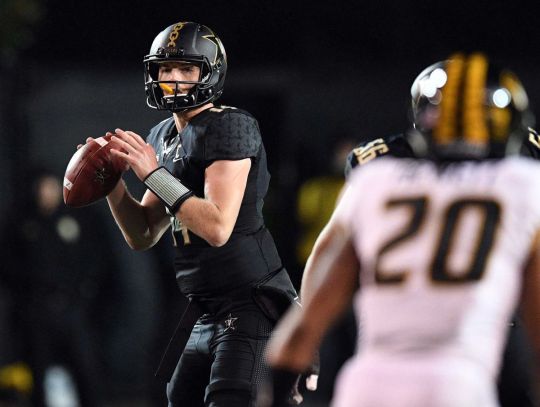
Kyle Shurmur
Christopher Hanewinckel-USA TODAY Sports
Of course, if the offense has risen, that must mean the defense has fallen. The Dores were 20th in Def. S&P+ in 2015 and 67th in 2017, and now they must replace two of their top three linemen, two of their top three linebackers, and five of their top eight defensive backs. They do return four of their top six producers of havoc plays (tackles for loss, passes defensed, forced fumbles), but depth will be tenuous unless redshirt freshmen and sophomores are ready. That’s doubly true up front, where the leading returning nose tackle made 1.5 tackles last year.
S&P+ favors the Commodores in four games this fall and projects them within a touchdown in four other games. If the offense can play at a top-50 level, that might be enough to get back to a bowl. But if the new hires at Florida and Tennessee click, finding six wins with basically a top-80 team every year is going to get more difficult. This would be a pretty good window to overachieve and change that trajectory a tad.
Offense
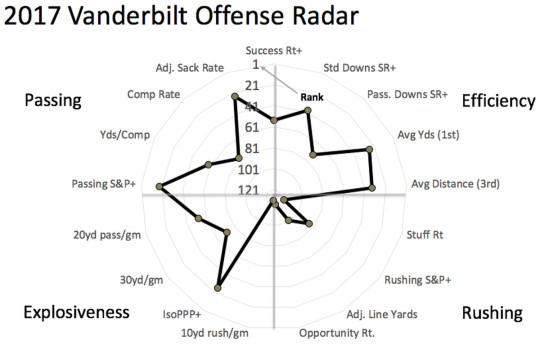
What felt like a 17-year college career for Ralph Webb has come to an end. That might not be a bad thing. Webb spent four seasons running into a clogged line but producing just enough breakout games to justify it. He finished with 4,173 career yards and 32 touchdowns, plus 68 receptions and another three scores through the air. But he only averaged better than 4.3 yards per carry in one year, and as he was asked to do less — his 192 carries in 2017 were 30 fewer than he had in any other season — Vandy’s offense did more.
A lot of that had to do with Shurmur. The idea of a running back who can carry a heavy load is tantalizing, but it only works if it helps your QB avoid second- or third-and-longs. Coordinator Andy Ludwig gave Shurmur more of an opportunity to throw in favorable downs and distances last year, and it paid off. VU went from running 62 percent of the time on standard downs to 54 percent and improved from 64th to 36th in standard-downs success rate.
Granted, Shumur’s still got some improving to do. After torching MTSU, Alabama A&M, and Kansas State to start 2017 (combined: 71 percent completion rate, 194.9 passer rating), he managed only a 118.4 rating and 54 percent completion rate over the next eight games before torching Tennessee in the finale.
With a sliding defense, Shurmur’s success is a grave necessity — the Commodores were 5-0 when his passer rating hit higher than 140 and 0-7 when it didn’t. In this regard, losing your security-blanket RB and your two most efficient receiving options isn’t automatically a good thing. C.J. Duncan and Trent Sherfield combined for a 60 percent receiving success rate, and every other wideout on the roster combined for 46 percent. That duo was a huge reason why Vandy ranked 12th in passing success rate.
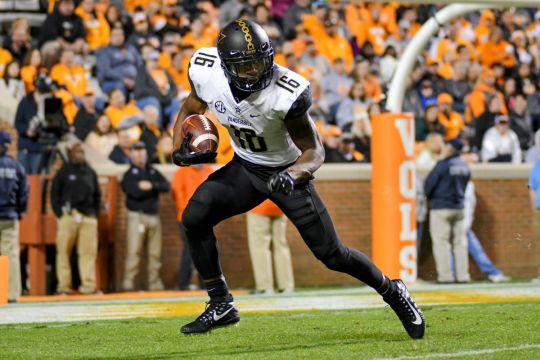
Kalija Lipscomb
Randy Sartin-USA TODAY Sports
Lipscomb emerged as a consistent weapon, going from 12 catches and 211 yards in the first six games to 25 for 399 in the last six. Junior Donaven Tennyson made five of his eight season receptions in the last three games, too.
There’s still room for newbies, though. Stump and redshirt freshman James Bostic provide bigger targets out side — each is listed at 6’3 and between 208 and 210 pounds. And if the freshmen are ready, there’s playing time available. Johnson and a couple of other physically ready first-year guys (6’3, 190-pound C.J. Bolar and 6’3, 205-pound Amir Abdur-Rahman) could find a niche.
At tight end, junior Jared Pinkney was productive during VU’s 3-0 start (nine catches, 125 yards) and erupted for six catches and 119 yards in a late-season loss to Missouri. He and senior Sam Dobbs (eight catches, 79 yards) have been around the block.
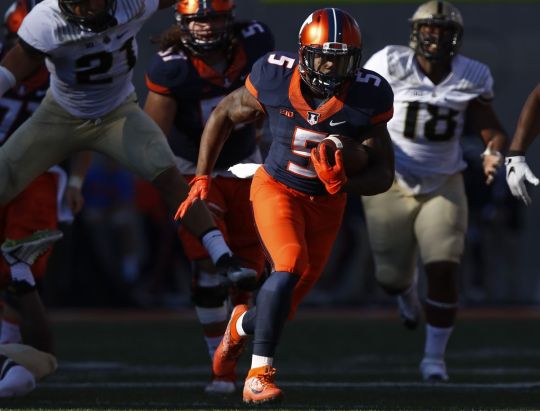
Ke’Shawn Vaughn
Photo by Michael Hickey/Getty Images
Vaughn was insanely volatile as a sophomore at Illinois in 2016; he produced an opportunity rate (percentage of carries gaining at least five yards) of just 27 percent, about 13 percentage points below the national average, but he made the most of basically every open-field opportunity he got. He’ll have some alls and some nothings.
(That’s more than we can say of Webb’s 2017 backups, Khari Blasingame and Jamauri Wakefield, who combined to average 3.6 yards per carry, 2.8 if you take out the Alabama A&M game.)
Despite Webb’s abilities to make people miss and fall forward, VU ranked 118th in stuff rate (run stops at or behind the line), 108th in power success rate, and 102nd in Adj. Line Yards. Pass protection improved — they went from 108th to 25th in Adj. Sack Rate, and that could mean far more than run blocking this year — but there’s room for improvement from left tackle Justin Skule and company.
The Read Option
A daily-ish mini-column on the college football thing of the day, with some other stuff too.
By signing up, you agree to our Privacy Policy and European users agree to the data transfer policy.
Defense
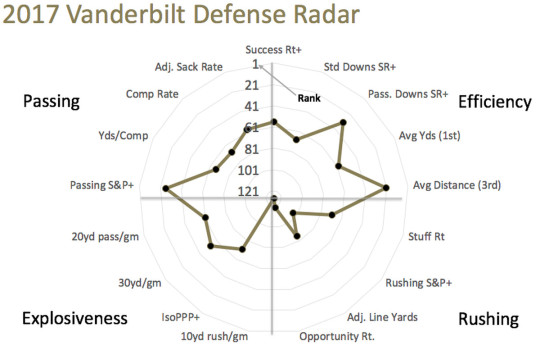
Back in 2015, VU used havoc to great effect. Linebackers Zach Cunningham and Stephen Weatherly combined for 26 tackles for loss and six sacks, while cornerback Torren McGaster produced 13 pass breakups and 4.5 TFLs. The Dores ranked 19th in overall havoc rate and 22nd in success rate.
Last year: 47th in the former, 66th in the latter. And the big plays they allowed were a lot bigger, too. They still did a pretty good job of capitalizing on passing downs (18th in PD success rate), but they had to wait for you to screw up to force any.
After four seasons of serving as his own coordinator, Mason brought Jason Tarver in to breathe some life. (You could say Mason demoted himself, I guess.) Tarver served as the Raiders’ coordinator for three years (2012-14) and has spent 16 of the last 17 seasons as an NFL assistant. The outlier year: a 2011 stint as Stanford’s coordinator and linebackers coach, where Mason was serving as co-coordinator.

Dare Odeyingbo
Kim Klement-USA TODAY Sports
Tarver’s Oakland defenses were pretty good against the run, so you can understand the draw of bringing him aboard. Vandy ranked 91st in Rushing S&P+ last year, and at SEC Media Days this year, Mason made a point of talking about more bulk up front.
Easier said than done. Starting nose tackle Nifae Lealao is gone; he was easily the Commodores’ biggest and most productive nose. The primary ends — senior Dare Odeyingbo and sophomores Dayo Odeyingbo (no relation ... just kidding) and Cameron Tidd — are all listed much bigger than last year, but sophomore nose Josiah Sa’o is the only listed 300-pounder among the most likely contributors.
At least the most disruptive guys are back. Inside linebacker Jordan Griffin and the elder Odeyingbo combined for 19.5 tackles for loss and, perhaps more importantly, 14 non-sack TFLs. They each took part in at least nine run stuffs on a defense desperate for them.
Still, the the other top two ILBs are gone, as are the top two nose tackles. Unless Tarver brings some exciting, effective new ideas to the table, it’s hard to assume the run defense improves much.
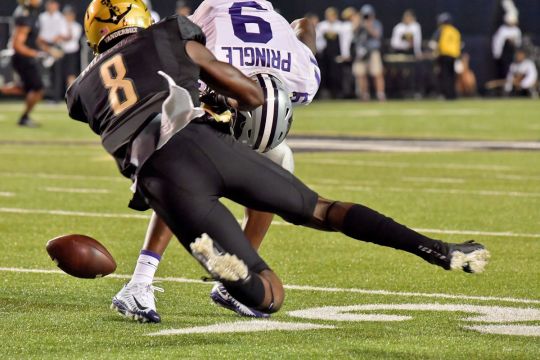
Joejuan Williams
Jim Brown-USA TODAY Sports
The same could be said about the pass defense. The pass rush is still going to be hard to handle thanks to the return of OLB Charles Wright (10.5 TFLs, nine of which were sacks) and the Odeyingbos. Corner Joejuan Williams (10 breakups, 2.5 TFLs) is a keeper, too. But the depth chart got thinned out — after Williams, safety LaDarius Wiley, and reserve CB Donovan Sheffield, the depth chart could be filled in entirely with freshmen and sophomores.
Mason brought in a trio of high-three- or four-star freshmen in the secondary, but they could contribute before they’re completely ready. And any injury to a veteran could be devastating.
Special Teams
Despite improving offensive efficiency, the combination of bad defensive efficiency and horrid special teams created a major field position disadvantage for a team that couldn’t afford such a thing. The Commodores were 101st in FBS and 13th in the SEC with a field position margin of minus-2.2 yards per drive. And they were 128th in Special Teams S&P+ thanks to short, returnable punts, a minimal return game, and a 3-for-7 performance on field goals.
Both punter Sam Loy and kicker Tommy Openshaw are gone, but the Dores probably aren’t going to regress anyway. Jamauri Wakefield appears to have some potential in kick returns, but he was all-or-nothing last year.
2018 outlook
2018 Schedule & Projection Factors
Date Opponent Proj. S&P+ Rk Proj. Margin Win Probability 1-Sep Middle Tennessee 83 4.4 60% 8-Sep Nevada 101 9.2 70% 15-Sep at Notre Dame 7 -24.9 8% 22-Sep South Carolina 35 -5.7 37% 29-Sep Tennessee State NR 23.1 91% 6-Oct at Georgia 6 -25.6 7% 13-Oct Florida 32 -6.7 35% 20-Oct at Kentucky 64 -5.3 38% 27-Oct at Arkansas 52 -7.2 34% 10-Nov at Missouri 30 -12.4 24% 17-Nov Ole Miss 25 -9.4 29% 24-Nov Tennessee 79 3.1 57%
After the last three years, it’s not hard to believe a five-win, No. 75 projection, is it? The offense could again progress if young receivers step up, and the defense might avoid further regression if new coaching and, again, youngsters come through.
The overall depth here is problematic, though, and the schedule, which features road trips to three projected top-30 teams (Georgia, Notre Dame, Mizzou) and visits from three others in the top 40, offers minimal margin for error. Vandy will need to win every winnable game (the Dores are projected favorites in four games) and ride big-play potential to a few upsets; otherwise, they’ll have gone through the Shurmur era while maxing out at six wins.
Vanderbilt isn’t underachieving under Mason. The Commodores are just ... achieving. There are worse fates than that, but if you’re a Vandy fan, you’re probably longing for a bit more.
Team preview stats
Dope article from sbnation.com
0 notes
Text
Live Update: Ranking the NFL’s Quarterbacks from 16 to 1
New Post has been published on https://livevsongame-tv.com/nfl/live-update-ranking-the-nfls-quarterbacks-from-16-to-1/22195/html
Live Update: Ranking the NFL’s Quarterbacks from 16 to 1
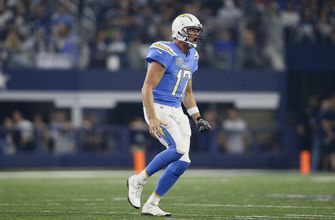

The NFL is a league, by-and-large, driven by quarterbacks. It is hard to win if a team’s signal caller is not up to par. Franchises that lack consistency under center are similar to trying to eat clam chowder with a fork. It is possible, but not the best way of going about winning or consuming such an exquisite dish.
The NFL has been completely parlayed into a league that values dual-threat passers. No longer, or rather hardly, do you see the “traditional” quarterbacks that move like they are stuck in quick sand when it is time to flee the pocket.
This list is a continuation of a countdown started last week pertaining to the league’s starting quarterbacks. The guys on this list are ascending in the right direction, well-established, or long for hardware to be slid onto their fourth finger. Statistics are hardly a factor as we work our way to the climax.
So without further ado, here are the quarterbacks that rank from 16 to 1:
16. Deshaun Watson
Watson played in seven games and had 19 touchdowns. He would have the chance to break Peyton Manning and Russell Wilson’s record of most passing touchdowns by a rookie (26) as well as set a new mark. It will be interesting to see if Watson plays with the same fearlessness in coming off a torn ACL, especially behind a leaky front. If he can play a full season, the Houston Texans should be a threat in the AFC South.
15. Dak Prescott
The Dallas Cowboys starter is entering his third year and he is supposed to be in a situation where the offense is catered to his strengths. Thus far, Prescott has built a reputation as a winning quarterback as the Cowboys have finished with a record above .500 in his first two years. He moves the chains with short-to-intermediate throws and his feet. However, the quarterbacks ranked higher than him do more than the bare minimum to win games. In other words, he has to push the ball down the field more or find a way to string together more monster performances.
14. Jared Goff
Lucky to have this guy leading the way. Congrats Coach! pic.twitter.com/kkdPgymibu
— Jared Goff (@JaredGoff16) February 4, 2018
Yes, Goff is ranked higher than Prescott despite seeing one less year of action, essentially. The former Golden Bear showed he can win and perform at a high level with the prerequisite talent. Goff gets the nod over his 2016 draft peer, Prescott, because he throws with more conviction and assurance. It has nothing to do with stats or wins and losses, right now. It is simply about the eye test.
13. Derek Carr
Like Marcus Mariota, Carr broke his leg in week 16 of the 2016 oddly enough. Like Mariota, he spent the 2017 season looking very hesitant and unsure of himself. Carr can make every throw, use his legs, and he plays with that backyard football energy that is infectious. It will be interesting to see if he meshes well with Jon Gruden as his new coach is already challenging him to be great. The Oakland Raiders need a MVP campaign from their signal caller if they want to be the center of attention out West.
12. Kirk Cousins
Cousins is sixth among active quarterbacks in passing yards per game (261.4). It has never been about statistics for him as it simply comes down to performing in big moments. In a 2016 playoff game against the Green Bay Packers, Cousins threw for 300+ yards and was not backing down in a duel with Aaron Rodgers. However, when it mattered the most, Cousins and the Washington Redskins failed to generate points on their final five drives.
In the 2016 season finale, Cousins threw two picks in a game that would have got his team into the postseason had they won it. The New York Giants were playing with a “C’s get the degree” mind frame too having already secured a playoff bid.
Cousins wanted to be viewed and paid as one of the league’s upper echelon at his position. The Redskins chose another route while the Minnesota Vikings were eager for him to sign. Washington might have lacked the talent to help him succeed, but in Minnesota he will be expected to win and win big.
11. Matthew Stafford
Stafford is one of the more underrated players the NFL has to offer. He is top 10 among active quarterbacks with 216 touchdowns. He can make throws at just about any angle, even left handed if he desired to do so. The Detroit Lions all-time leading passer needs to muster up some wins as he is just 60-65 in his career.
10. Cam Newton
We like this day 😎#NationalHandshakeDay pic.twitter.com/dlqrIFHm5i
— Carolina Panthers (@Panthers) June 28, 2018
The 2015 MVP would be a lot higher on this list had the Carolina Panthers won Super Bowl 50 against the Denver Broncos. In 2016, we saw Newton revert as he lost his passion and fire for the game. He got back to having fun last year and even rushed for a career-high 754 yards. With a new offensive coordinator in Norv Turner, Newton could benefit from a new scheme that is predicated on pushing the ball down the field. He has the arm and the skilled players out wide in Devin Funchess, Torrey Smith, Curtis Samuel, and rookie DJ Moore to produce some magic.
9. Matt Ryan
Another NFC South quarterback who would be higher on this list had he won a Super Bowl. Nevertheless, Ryan is like a surgeon on the field as he knows all of the little areas of the opposing defenses to apply pressure. The Atlanta Falcons star is five wins away from the century mark and is fourth among active throwers with 35 game-winning drives. Why else would they refer to him as “Matty Ice”?
8. Russell Wilson
Wilson is as cool as they come under pressure, both literally and figuratively. He was sacked 43 times behind a Seattle Seahawks front that needs more than Flex Seal to stop a leak. His line was so woebegone that he had to use his feet more often than he would have liked. Wilson led his team in passing and rushing yardage a year ago. What more could you want from the guy?
7. Andrew Luck
The Indianapolis Colts top gun missed an entire season and is still a top 10 quarterback. Imagine if he could get some resistance up front with a consistent rushing attack. Luck could very well end up top three at his position by the end of the season if he is truly back and playing like his chipper self. The Colts have to tread lightly with him.
6. Philip Rivers
Philip Rivers showed he has still got it with his performances towards the end of the 2017 season. pic.twitter.com/igoivQINdk
— Pro Football Focus (@PFF) July 1, 2018
Rivers is one of four quarterbacks to throw for over 4,000 yards the last five seasons. He has been one of the league’s unheralded stars in the last decade, but he is starting to get more notoriety as his team’s expectations grow. The Los Angeles Chargers are being dubbed as a team that could thwart the New England Patriots in the AFC and maybe win a Super Bowl. Those are lofty expectations being heaped on a team that missed the playoffs a year ago. It starts and ends with their captain, their quarterback, and their heart-and-soul in no. 17.
5. Carson Wentz
What a perfect scenario it would have been if Wentz finished the year and led the Philadelphia Eagles to a Super Bowl while receiving league MVP. However, destiny had other plans. Nevertheless, Wentz could rival other signal callers like Luck as heir to the throne once the guys ranked higher than him retire. He is built like Big Ben at 6’5 and nearly 240 pounds. He is as nimble as Wilson. Lastly, he has the improvisation of Stafford. As you can see, Wentz has a lot of features that exist with other upper level passers. Last year was simply a prelude of things to come for Wentz.
4. Ben Roethlisberger
Big Ben must have been a huge The Clash fan growing up as “Should I Stay or Should I Go?” seemed to percolate all season for the two-time Super Bowl champ a year ago. All of a sudden, he came to his senses when the Pittsburgh Steelers brass drafted a Big Ben prototype in Mason Rudolph. A sense of pride seems to exist now in Roethlisberger one that the Steelers hope will galvanize them to another ring. By the way, he finished top five in passing yardage in what was a “down year” by his standards.
3. Drew Brees
The definition of insanity is trying something over and over again and expecting a different result. At one point, the New Orleans Saints could have been considered an insane organization for repeating the same habits that inhibited their ability to win. Sure, Brees would hover at the 5,000-yard mark from 2011 to 2016, but they were predictable without a formidable rushing attack.
The Saints decided to develop a run game headlined by Mark Ingram and Alvin Kamara. Brees only had 4,334 yards, his lowest mark since 2007, but he set a new league record with a 72 percent completion percentage. Also, he only threw eight picks, which was his lowest total since 2004. As a result, the Saints went to the playoffs for the first time since 2013 with a reformed Brees. Will he stay true to his new form or revert back to old habits?
2. Tom Brady
Five-time Super Bowl champion. Three-time league MVP. Heck, Brady even led the league in passing yardage with 4,577 yards in 2017. However, the face of the New England Patriots’ franchise is NOT the best quarterback. The best comparison for Brady would be to Kobe Bryant when he was winning his rings with Pau Gasol. Despite it all, LeBron James was still the better individual player. That is just how the cookie crumbles here and with the next guy on this list missing significant time last year it is easy to be a prisoner of the moment when it comes to Brady. He tops nearly every statistic of both active and all-time lists, but there is another Super Bowl winning California native that is better than him.
1. Aaron Rodgers
✊ Another Sunday closer to 🏈#GoPackGo pic.twitter.com/gFdF4c2kZi
— Green Bay Packers (@packers) July 1, 2018
From an individual’s perspective and at this point in time, Rodgers is better than Brady. Not all time, simply right now.
Rodgers is the Baba Yaga of the NFL and that is “The Boogeyman” for those that have never seen John Wick. When building a team and with the way the game has evolved in favoring dual-threat throwers, you would be hard-pressed to find many people not going with Rodgers. He can do it all.
The former Cal great can throw back over the middle late, throws into cracks and crevices that should not be thrown into, and steals a win or two with Hail Mary attempts. Those are just a few things Rodgers can do that are considered ill-advised or impossible. His arm talent is one of the best ever and when Rodgers smiles during a game it is usually an indication of bad things to come for the opposing team. Now, I am not clairvoyant, but another Super Bowl could make him “the greatest quarterback of all-time”. Ponder that.
Rodgers reigns supreme here on this list of the NFL’s elite. At the end of the day, the quarterbacks that rank from 1-10 are capable of winning on any given Sunday. Their legacies, however, vary.
(function() var isTouch = window.navigator.userAgent.match(/Android());
Source by [Anando]
0 notes
Text
The best way to spend less? Cut back on the big stuff!
Get Rich Slowly, 19 Mar 2018
You don’t need a high income to achieve Financial Independence.
Making more money helps, sure, but if you’re diligent about cutting costs, it’s possible to reach financial freedom on even an average salary.
I want you to meet my friend, John. John is an 81-year-old retired shop teacher. He’s a millionaire--but you’d never know it.
John started life as a carpenter. In his thirties, he went back to school to become a teacher. He spent the next twenty years teaching shop at a junior high school in a poor part of town. He retired to financial freedom at age 58. He never had a huge income and he didn’t inherit a fortune.
So, how’d he get rich? He pinched his pennies and doted on his dollars. John achieved Financial Independence by ruthlessly cutting costs.
John doesn’t live in a mansion. He lives in the same small ranch house he bought for $10,500 in 1962. He paid off his mortgage early, and has now lived in the place for 53 years!
John doesn’t drive a brand-new Mercedes or BMW. He drives a 1998 Chevy minivan he bought for cheap five years ago. It’s ugly, but he doesn’t care. It meets his needs and he has no plans to upgrade.
John doesn’t take lavish vacations. He spends his summers in southeast Alaska on an old 38-foot fishing boat that he bought with cash in 1995. He spends his winters doing volunteer work on farms and ranches in New Zealand.
John doesn’t like to dine in fancy restaurants. He’d rather make his own meals at home. “For me, restaurants are a waste of money,” he says. “I don’t appreciate them.”
We’re constantly bombarded by messages that wealthy people enjoy lavish lifestyles filled with luxury. From my experience meeting with dozens of millionaires over the past decade, this kind of lifestyle is the exception, not the rule.
Most wealthy people I know are like John. They’re quiet millionaires. They practice stealth wealth.
But don’t just take my word for it. Let’s look at what the experts say.
In The Millionaire Next Door, authors Thomas Stanley and William Danko share what they learned through years of academic research into the habits of America’s wealthy. Here’s one key takeaway:
What are three words that profile the affluent? FRUGAL FRUGAL FRUGAL…Being frugal is the cornerstone of wealth-building.
They write that millionaires tend to “play great offense” with money--their incomes are much higher than average--but they also “play great defense”. They’re not big spenders. They’re thrifty. They opt out of consumer culture, making purchases based on their personal needs and wants rather than status and fashion.
“Few people can sustain profligate spending habits and simultaneously build wealth,” write the authors. “[Millionaires] became millionaires by budgeting and controlling expenses, and they maintain their affluent status the same way.”
Study after study shows the same thing. To get and stay rich, you have to manage your lifestyle. You can’t outearn dumb spending.
Great. You get it. To achieve your goals, you’ve got to cut costs. But how?
There are two schools of thought:
Most money writers emphasize saving on small stuff. They teach how to clip coupons, conserve electricity, and spend less on entertainment. These small wins are usually quick and easy to achieve.
A few folks urge readers to pursue “big wins”. They argue that the quickest way to wealth is to spend less on big-ticket items like your home and your car. The downside to this approach? Big wins take a lot of work, and opportunities to pursue them are rare.
I believe that a smart money manager does both. She practices thrift on a daily basis and she seizes every opportunity to slash spending on the big stuff.
You could save maybe 50 cents a day by drinking a glass of water instead of a can of soda. That doesn’t mean much if you only do it once, but over the course of an entire year that single change would increase your personal profit by nearly $200. When taken together, many such small economies make a noticeable difference.
Small amounts do matter.
Rather than provide some made-up examples of how much you could save, here are actual numbers from my own life. When I dug out of $35,000 in debt a few years ago, I decided to:
Switch my cable TV package from $65.82 per month to $12.01 per month, saving $645.72 every year.
Get rid of my home phone line (roughly $46.50 per month) and my subscription to Audible ($21.95 per month), saving $821.40 per year.
Cancel my magazine and newspaper subscriptions, saving $137 per year.
Make use of the public library instead of shopping at bookstores, saving $391.95 in the first year.
Plant a vegetable garden to grow my own produce, saving more than $300 per year. (Yes, I’m such a nerd that I kept a spreadsheet to track how much I saved!)
With these changes alone, I increased my cash flow by $2,281.61 per year. That’s an additional profit of almost $200 every month.
You won’t get rich--slowly or otherwise--by cutting your cable bill or growing your own tomatoes. But when small changes are a part of an ongoing campaign of saving and investing, they can bring big changes indeed!
True story: I recently had a friend ask me how to get out of debt. “You can start by getting rid of your $200 cable package,” I told him. “No way!” he said. “That’s the first thing everyone says, and it’ll be the last to go. TV is important to me.” Right. More important than being debt-free, apparently.
While it’s important to save money on everyday stuff, it’s even more important to watch how much you spend on major purchases. By making smart choices on big-ticket items, you can save thousands of dollars in one blow. If you spend fifty grand less when you buy a house, that’s fifty grand (or more!) you never have to earn.
Housing: Housing is the biggest expense for most Americans--and by a wide margin. According to the U.S. Bureau of Labor Statistics’ 2015 Consumer Expenditure Survey, the typical American household spends 32.8% of its income on housing, which includes mortgage (or rent), maintenance, insurance, interest, and utilities.
In an ideal world, you’d slash your housing expense by buying an affordable home in a city with a low cost of living.
While relocating to a cheaper home in a cheaper city would probably provide a huge financial reward, it’s not exactly easy. A more practical alternative might be to move within your current city. Sell your home (or move out of your rental) and choose something more affordable.
Think about it: If you’re an average American who spends $1534 per month on a place to live, dropping that expense by 10% would save you $150 per housing payment. Drop it by 30% and you’ll save more than $5000 per year!
Transportation: Transportation is our second-largest expense in the U.S. We spend an average of $792 per month (17 percent of the typical budget) to get around, including vehicle payments, gasoline, insurance, and repairs. I know Americans love their automobiles. They’re loath to let them go, even in the face of logic. But imagine how much you could save if you could cut your car costs in half! How do you do that?
Sell your current car. Replace it with a used vehicle, one that’s fuel efficient. (Side benefit: An older, used vehicle will cost less to insure!)
Drive your car only when necessary. When possible, bike or walk to reach your destination. (Side benefit: Increased fitness, which also saves you money!)
Make use of public transportation. (Side benefit: Time to read!)
When I recommend people change the way they get around, I’m usually met with a wall of objections. But let me suggest that instead of looking for reasons you can’t do this, instead look for ways you can. You’ll save buckets of money.
Other expenses: Together, housing and transportation consume half of the average American budget. There are enormous opportunities to save if you choose to economize on these two categories. But you can achieve big wins in other areas too.
The Consumer Expenditure Survey shows that the typical household spent $1846 on clothing in 2015, $4342 on health care, $2842 on entertainment, and $7023 on food.
Because each of us is different and we spend in different ways, opportunities for big wins vary from person to person. After tracking my spending for the last half of 2013, for instance, I realized that I was spending way too much on travel. In 2014, I cut my travel costs in half. This allowed me to save money for other goals, such as buying a motorhome.
The Best Way to Spend Less: A few years ago, I asked my friend John if he had advice for young people who want to retire early.
“Here’s the secret to financial freedom,” he told me. “I don’t care how much you make--you spend less than you earn. You don’t have to like it. You just have to do it. Because that is the secret.”
The best way to spend less is to optimize the big stuff.
I’m not saying you shouldn’t make your own laundry detergent or plant a vegetable garden. By all means, do these things! But understand that if all you do is the small stuff, your only hope is to get rich slowly. You can do better.
0 notes
Text
The best way to spend less? Cut back on the big stuff!
New Post has been published on http://foursprout.com/wealth/the-best-way-to-spend-less-cut-back-on-the-big-stuff/
The best way to spend less? Cut back on the big stuff!
Important note: If you received this article by email, you are subscribed to the old daily GRS email list, which is going away soon. If you’d like to read Get Rich Slowly by email, subscribe to the new, weekly GRS newsletter here.
You don’t need a high income to achieve Financial Independence.
Making more money helps, sure, but if you’re diligent about cutting costs, it’s possible to reach financial freedom on even an average salary.
I want you to meet my friend, John. John is an 81-year-old retired shop teacher. He’s a millionaire — but you’d never know it.
John started life as a carpenter. In his thirties, he went back to school to become a teacher. He spent the next twenty years teaching shop at a junior high school in a poor part of town. He retired to financial freedom at age 58. He never had a huge income and he didn’t inherit a fortune.
So, how’d he get rich? He pinched his pennies and doted on his dollars. John achieved Financial Independence by ruthlessly cutting costs.
John doesn’t live in a mansion. He lives in the same small ranch house he bought for $10,500 in 1962. He paid off his mortgage early, and has now lived in the place for 53 years!
John doesn’t drive a brand-new Mercedes or BMW. He drives a 1998 Chevy minivan he bought for cheap five years ago. It’s ugly, but he doesn’t care. It meets his needs and he has no plans to upgrade.
John doesn’t take lavish vacations. He spends his summers in southeast Alaska on an old 38-foot fishing boat that he bought with cash in 1995. He spends his winters doing volunteer work on farms and ranches in New Zealand.
John doesn’t like to dine in fancy restaurants. He’d rather make his own meals at home. “For me, restaurants are a waste of money,” he says. “I don’t appreciate them.”
Does John sound like a typical millionaire to you? If you were to believe TV, movies, and magazines, you might think most millionaires live like this:
We’re constantly bombarded by messages that wealthy people enjoy lavish lifestyles filled with luxury. From my experience meeting with dozens of millionaires over the past decade, this kind of lifestyle is the exception not the rule.
Most wealthy people I know are like John. They’re quiet millionaires. They practice stealth wealth.
But don’t just take my word for it. Let’s look at what the experts say.
Lifestyles of the Rich and Fameless
In The Millionaire Next Door, authors Thomas Stanley and William Danko share what they learned through years of academic research into the habits of America’s wealthy. Here’s one key takeaway:
What are three words that profile the affluent? FRUGAL FRUGAL FRUGAL…Being frugal is the cornerstone of wealth-building.
They write that millionaires tend to “play great offense” with money — their incomes are much higher than average — but they also “play great defense”. They’re not big spenders. They’re thrifty. They opt out of consumer culture, making purchases based on their personal needs and wants rather than status and fashion.
“Few people can sustain profligate spending habits and simultaneously build wealth,” write the authors. “[Millionaires] became millionaires by budgeting and controlling expenses, and they maintain their affluent status the same way.”
Study after study shows the same thing. To get and stay rich, you have to manage your lifestyle. You can’t outearn dumb spending.
Great. You get it. To achieve your goals, you’ve got to cut costs. But how?
There are two schools of thought:
Most money writers emphasize saving on small stuff. They teach how to clip coupons, conserve electricity, and spend less on entertainment. These small wins are usually quick and easy to achieve.
A few folks urge readers to pursue “big wins”. They argue that the quickest way to wealth is to spend less on big-ticket items like your home and your car. The downside to this approach? Big wins take a lot of work, and opportunities to pursue them are rare.
I believe that a smart money manager does both. She practices thrift on a daily basis and she seizes every opportunity to slash spending on the big stuff.
Frugality is an Important Part of Personal Finance
You could save maybe 50 cents a day by drinking a glass of water instead of a can of soda. That doesn’t mean much if you only do it once, but over the course of an entire year that single change would increase your personal profit by nearly $200. When taken together, many such small economies make a noticeable difference.
Small amounts do matter.
Rather than provide some made-up examples of how much you could save, here are actual numbers from my own life. When I dug out of $35,000 in debt a few years ago, I decided to:
Switch my cable TV package from $65.82 per month to $12.01 per month, saving $645.72 every year.
Get rid of my home phone line (roughly $46.50 per month) and my subscription to Audible ($21.95 per month), saving $821.40 per year.
Cancel my magazine and newspaper subscriptions, saving $137 per year.
Make use of the public library instead of shopping at bookstores, saving $391.95 in the first year.
Plant a vegetable garden to grow my own produce, saving more than $300 per year. (Yes, I’m such a nerd that I kept a spreadsheet to track how much I saved!)
With these changes alone, I increased my cash flow by $2,281.61 per year. That’s an additional profit of almost $200 every month.
You won’t get rich — slowly or otherwise — by cutting your cable bill or growing your own tomatoes. But when small changes are a part of an ongoing campaign of saving and investing, they can bring big changes indeed!
True story: I recently had a friend ask me how to get out of debt. “You can start by getting rid of your $200 cable package,” I told him. “No way!” he said. “That’s the first thing everyone says, and it’ll be the last to go. TV is important to me.” Right. More important than being debt-free, apparently.
The Magic of Thinking Big
While it’s important to save money on everyday stuff, it’s even more important to watch how much you spend on major purchases. By making smart choices on big-ticket items, you can save thousands of dollars in one blow. If you spend fifty grand less when you buy a house, that’s fifty grand (or more!) you never have to earn.
Housing
Housing is the biggest expense for most Americans — and by a wide margin. According to the U.S. Bureau of Labor Statistics’ 2015 Consumer Expenditure Survey, the typical American household spends 32.8% of its income on housing, which includes mortgage (or rent), maintenance, insurance, interest, and utilities.
In an ideal world, you’d slash your housing expense by buying an affordable home in a city with a low cost of living.
While relocating to a cheaper home in a cheaper city would probably provide a huge financial reward, it’s not exactly easy. A more practical alternative might be to move within your current city. Sell your home (or move out of your rental) and choose something more affordable.
Think about it: If you’re an average American who spends $1534 per month on a place to live, dropping that expense by 10% would save you $150 per housing payment. Drop it by 30% and you’ll save more than $5000 per year!
“If you’re not yet wealthy but want to be someday, never purchase a home that requires a mortgage that is more than twice your household’s annual realized income. Living in less costly areas can enable you to spend less and to invest more of your income. You will pay less for your home and correspondingly less for your property taxes. Your neighbors will be less likely to drive expensive motor vehicles. You will find it easier to keep up, even ahead, of the Joneses and still accumulate wealth.” — The Millionaire Next Door
Transportation
Transportation is our second-largest expense in the U.S. We spend an average of $792 per month (17 percent of the typical budget) to get around, including vehicle payments, gasoline, insurance, and repairs. I know Americans love their automobiles. They’re loath to let them go, even in the face of logic. But imagine how much you could save if you could cut your car costs in half! How do you do that?
Sell your current car. Replace it with a used vehicle, one that’s fuel efficient. (Side benefit: An older, used vehicle will cost less to insure!)
Drive your car only when necessary. When possible, bike or walk to reach your destination. (Side benefit: Increased fitness, which also saves you money!)
Make use of public transportation. (Side benefit: Time to read!)
When I recommend people change the way they get around, I’m usually met with a wall of objections. But let me suggest that instead of looking for reasons you can’t do this, instead look for ways you can. You’ll save buckets of money.
Other expenses
Together, housing and transportation consume half of the average American budget. There are enormous opportunities to save if you choose to economize on these two categories. But you can achieve big wins in other areas too.
The Consumer Expenditure Survey shows that the typical household spent $1846 on clothing in 2015, $4342 on health care, $2842 on entertainment, and $7023 on food.
Because each of us is different and we spend in different ways, opportunities for big wins vary from person to person. After tracking my spending for the last half of 2013, for instance, I realized that I was spending way too much on travel. In 2014, I cut my travel costs in half. This allowed me to save money for other goals, such as buying a motorhome.
The Best Way to Spend Less
A few years ago, I asked my friend John if he had advice for young people who want to retire early.
“Here’s the secret to financial freedom,” he told me. “I don’t care how much you make — you spend less than you earn. You don’t have to like it. You just have to do it. Because that is the secret.”
The best way to spend less is to optimize the big stuff.
I’m not saying you shouldn’t make your own laundry detergent or plant a vegetable garden. By all means, do these things! But understand that if all you do is the small stuff, your only hope is to get rich slowly. You can do better.
Exercise
Pull out your personal mission statement. With that in front of you, brainstorm ways to reduce your spending. No idea is too small. No idea is too big. No idea is too stupid. Do a rapid braindump of any (and all) actions you could take to cut costs. If all your spending were aligned with your goals and mission, where would the money go?
After you’re finished brainstorming, pick three specific ways — large or small — you’ll reduce spending starting this week. (Examples: I’ll walk to the grocery store. I’ll sign up for a library card. I’ll finally cancel my landline.) Also pick one “big win” that you will work to achieve in, say, the next two years. Make this a big, hairy audacious goal. (Example: We’ll go from a three-car family to a one-car family.)
Note: During the month of March, I’m migrating old Money Boss material to Get Rich Slowly — including the articles that describe the “Money Boss method”. This is the fifth of those articles.
Part one answered the question, “What is financial independence?”
Part two looked at why you should run your life like a business.
Part three explained how to write a personal mission statement.
Part four explored the importance of saving rate.
Look for further installments in the “Money Boss method” series twice a week until they’ve all been transferred from the old site.
The post The best way to spend less? Cut back on the big stuff! appeared first on Get Rich Slowly.
0 notes
Text
The best way to spend less? Cut back on the big stuff!
New Post has been published on http://foursprout.com/wealth/the-best-way-to-spend-less-cut-back-on-the-big-stuff/
The best way to spend less? Cut back on the big stuff!
Important note: If you received this article by email, you are subscribed to the old daily GRS email list, which is going away soon. If you’d like to read Get Rich Slowly by email, subscribe to the new, weekly GRS newsletter here.
You don’t need a high income to achieve Financial Independence.
Making more money helps, sure, but if you’re diligent about cutting costs, it’s possible to reach financial freedom on even an average salary.
I want you to meet my friend, John. John is an 81-year-old retired shop teacher. He’s a millionaire — but you’d never know it.
John started life as a carpenter. In his thirties, he went back to school to become a teacher. He spent the next twenty years teaching shop at a junior high school in a poor part of town. He retired to financial freedom at age 58. He never had a huge income and he didn’t inherit a fortune.
So, how’d he get rich? He pinched his pennies and doted on his dollars. John achieved Financial Independence by ruthlessly cutting costs.
John doesn’t live in a mansion. He lives in the same small ranch house he bought for $10,500 in 1962. He paid off his mortgage early, and has now lived in the place for 53 years!
John doesn’t drive a brand-new Mercedes or BMW. He drives a 1998 Chevy minivan he bought for cheap five years ago. It’s ugly, but he doesn’t care. It meets his needs and he has no plans to upgrade.
John doesn’t take lavish vacations. He spends his summers in southeast Alaska on an old 38-foot fishing boat that he bought with cash in 1995. He spends his winters doing volunteer work on farms and ranches in New Zealand.
John doesn’t like to dine in fancy restaurants. He’d rather make his own meals at home. “For me, restaurants are a waste of money,” he says. “I don’t appreciate them.”
Does John sound like a typical millionaire to you? If you were to believe TV, movies, and magazines, you might think most millionaires live like this:
We’re constantly bombarded by messages that wealthy people enjoy lavish lifestyles filled with luxury. From my experience meeting with dozens of millionaires over the past decade, this kind of lifestyle is the exception not the rule.
Most wealthy people I know are like John. They’re quiet millionaires. They practice stealth wealth.
But don’t just take my word for it. Let’s look at what the experts say.
Lifestyles of the Rich and Fameless
In The Millionaire Next Door, authors Thomas Stanley and William Danko share what they learned through years of academic research into the habits of America’s wealthy. Here’s one key takeaway:
What are three words that profile the affluent? FRUGAL FRUGAL FRUGAL…Being frugal is the cornerstone of wealth-building.
They write that millionaires tend to “play great offense” with money — their incomes are much higher than average — but they also “play great defense”. They’re not big spenders. They’re thrifty. They opt out of consumer culture, making purchases based on their personal needs and wants rather than status and fashion.
“Few people can sustain profligate spending habits and simultaneously build wealth,” write the authors. “[Millionaires] became millionaires by budgeting and controlling expenses, and they maintain their affluent status the same way.”
Study after study shows the same thing. To get and stay rich, you have to manage your lifestyle. You can’t outearn dumb spending.
Great. You get it. To achieve your goals, you’ve got to cut costs. But how?
There are two schools of thought:
Most money writers emphasize saving on small stuff. They teach how to clip coupons, conserve electricity, and spend less on entertainment. These small wins are usually quick and easy to achieve.
A few folks urge readers to pursue “big wins”. They argue that the quickest way to wealth is to spend less on big-ticket items like your home and your car. The downside to this approach? Big wins take a lot of work, and opportunities to pursue them are rare.
I believe that a smart money manager does both. She practices thrift on a daily basis and she seizes every opportunity to slash spending on the big stuff.
Frugality is an Important Part of Personal Finance
You could save maybe 50 cents a day by drinking a glass of water instead of a can of soda. That doesn’t mean much if you only do it once, but over the course of an entire year that single change would increase your personal profit by nearly $200. When taken together, many such small economies make a noticeable difference.
Small amounts do matter.
Rather than provide some made-up examples of how much you could save, here are actual numbers from my own life. When I dug out of $35,000 in debt a few years ago, I decided to:
Switch my cable TV package from $65.82 per month to $12.01 per month, saving $645.72 every year.
Get rid of my home phone line (roughly $46.50 per month) and my subscription to Audible ($21.95 per month), saving $821.40 per year.
Cancel my magazine and newspaper subscriptions, saving $137 per year.
Make use of the public library instead of shopping at bookstores, saving $391.95 in the first year.
Plant a vegetable garden to grow my own produce, saving more than $300 per year. (Yes, I’m such a nerd that I kept a spreadsheet to track how much I saved!)
With these changes alone, I increased my cash flow by $2,281.61 per year. That’s an additional profit of almost $200 every month.
You won’t get rich — slowly or otherwise — by cutting your cable bill or growing your own tomatoes. But when small changes are a part of an ongoing campaign of saving and investing, they can bring big changes indeed!
True story: I recently had a friend ask me how to get out of debt. “You can start by getting rid of your $200 cable package,” I told him. “No way!” he said. “That’s the first thing everyone says, and it’ll be the last to go. TV is important to me.” Right. More important than being debt-free, apparently.
The Magic of Thinking Big
While it’s important to save money on everyday stuff, it’s even more important to watch how much you spend on major purchases. By making smart choices on big-ticket items, you can save thousands of dollars in one blow. If you spend fifty grand less when you buy a house, that’s fifty grand (or more!) you never have to earn.
Housing
Housing is the biggest expense for most Americans — and by a wide margin. According to the U.S. Bureau of Labor Statistics’ 2015 Consumer Expenditure Survey, the typical American household spends 32.8% of its income on housing, which includes mortgage (or rent), maintenance, insurance, interest, and utilities.
In an ideal world, you’d slash your housing expense by buying an affordable home in a city with a low cost of living.
While relocating to a cheaper home in a cheaper city would probably provide a huge financial reward, it’s not exactly easy. A more practical alternative might be to move within your current city. Sell your home (or move out of your rental) and choose something more affordable.
Think about it: If you’re an average American who spends $1534 per month on a place to live, dropping that expense by 10% would save you $150 per housing payment. Drop it by 30% and you’ll save more than $5000 per year!
“If you’re not yet wealthy but want to be someday, never purchase a home that requires a mortgage that is more than twice your household’s annual realized income. Living in less costly areas can enable you to spend less and to invest more of your income. You will pay less for your home and correspondingly less for your property taxes. Your neighbors will be less likely to drive expensive motor vehicles. You will find it easier to keep up, even ahead, of the Joneses and still accumulate wealth.” — The Millionaire Next Door
Transportation
Transportation is our second-largest expense in the U.S. We spend an average of $792 per month (17 percent of the typical budget) to get around, including vehicle payments, gasoline, insurance, and repairs. I know Americans love their automobiles. They’re loath to let them go, even in the face of logic. But imagine how much you could save if you could cut your car costs in half! How do you do that?
Sell your current car. Replace it with a used vehicle, one that’s fuel efficient. (Side benefit: An older, used vehicle will cost less to insure!)
Drive your car only when necessary. When possible, bike or walk to reach your destination. (Side benefit: Increased fitness, which also saves you money!)
Make use of public transportation. (Side benefit: Time to read!)
When I recommend people change the way they get around, I’m usually met with a wall of objections. But let me suggest that instead of looking for reasons you can’t do this, instead look for ways you can. You’ll save buckets of money.
Other expenses
Together, housing and transportation consume half of the average American budget. There are enormous opportunities to save if you choose to economize on these two categories. But you can achieve big wins in other areas too.
The Consumer Expenditure Survey shows that the typical household spent $1846 on clothing in 2015, $4342 on health care, $2842 on entertainment, and $7023 on food.
Because each of us is different and we spend in different ways, opportunities for big wins vary from person to person. After tracking my spending for the last half of 2013, for instance, I realized that I was spending way too much on travel. In 2014, I cut my travel costs in half. This allowed me to save money for other goals, such as buying a motorhome.
The Best Way to Spend Less
A few years ago, I asked my friend John if he had advice for young people who want to retire early.
“Here’s the secret to financial freedom,” he told me. “I don’t care how much you make — you spend less than you earn. You don’t have to like it. You just have to do it. Because that is the secret.”
The best way to spend less is to optimize the big stuff.
I’m not saying you shouldn’t make your own laundry detergent or plant a vegetable garden. By all means, do these things! But understand that if all you do is the small stuff, your only hope is to get rich slowly. You can do better.
Exercise
Pull out your personal mission statement. With that in front of you, brainstorm ways to reduce your spending. No idea is too small. No idea is too big. No idea is too stupid. Do a rapid braindump of any (and all) actions you could take to cut costs. If all your spending were aligned with your goals and mission, where would the money go?
After you’re finished brainstorming, pick three specific ways — large or small — you’ll reduce spending starting this week. (Examples: I’ll walk to the grocery store. I’ll sign up for a library card. I’ll finally cancel my landline.) Also pick one “big win” that you will work to achieve in, say, the next two years. Make this a big, hairy audacious goal. (Example: We’ll go from a three-car family to a one-car family.)
Note: During the month of March, I’m migrating old Money Boss material to Get Rich Slowly — including the articles that describe the “Money Boss method”. This is the fifth of those articles.
Part one answered the question, “What is financial independence?”
Part two looked at why you should run your life like a business.
Part three explained how to write a personal mission statement.
Part four explored the importance of saving rate.
Look for further installments in the “Money Boss method” series twice a week until they’ve all been transferred from the old site.
The post The best way to spend less? Cut back on the big stuff! appeared first on Get Rich Slowly.
0 notes
Text
The 2017 Baseball Memorabilia Haul
I’ve delayed this long enough. 2016 was a big year for me in terms of no longer just buying cards of guys from the 1980′s and 1990′s. I ventured out and started spending money on stars playing today, and prospects for the future! I continued that this year, but also filled out a lot more players on that 1980/1990 list that I’ve been working on!
2017 was by far my biggest year ever in terms of collecting cards. The most I’ve ever gotten in a single year. I hope you enjoy checkin’ em out!!!
FIRST THINGS FIRST. THE ALBERT PUJOLS FROM LAST YEAR.

BIG BOY CAME BACK A 9! Which is crazy good! I’m ecstatic about it. The Corners sub-graded an 8.5 and the Edges graded a 9, while the Surface & Centering hit at 9.5. Part of me wants to do a re-grade to see if the corners and edges could possibly come back a bit higher... but hey. a 9 is still insane. And that auto is great.
Albert is currently looking like he’s at the end of his career, but even if he sticks around for another several years being basically unplayable - his peak was so nuts he will still be regarded as one of the best players in Baseball history.
Now to the new additions to the collection, by order of when I received them:
01.) 2013 BBM SCM Original #206 - Shohei Ohtani (BGS 9.5)
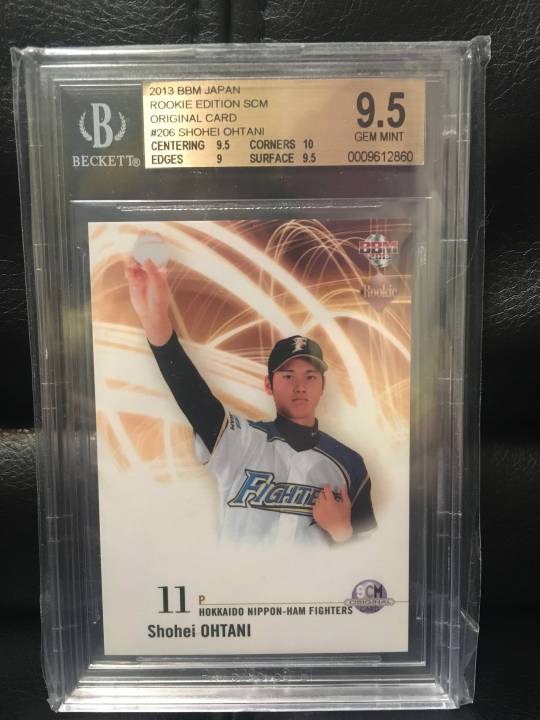
Newest big star in MLB. Shohei Ohtani is an awesome pitcher, and what makes him unique is he’s also great with a bat. Was desperately hoping he was going to sign with the Yankees, but unfortunately he came in immediately deciding he didn’t want to live on the East Coast. Which sucks. Boo. But hey, I hope he still does good. Just not against us.
02.) 1989 Donruss #635 - Curt Schilling (PSA 10)

Curt Schilling is a piece of crap. A terrible person, with terrible opinions, and his attitude keeping him out of the Hall of Fame so far has brought me some great joy.
With that said he’s one of the best pitchers of all time. His unpopularity atm made this purchase very easy on my wallet.
03.) 1983 Fritsch #013 - Jose Canseco (PSA 10)

Before Jose Canseco lost his finger and opened up a can of worms about steroids, he hit a lot of dingers and was very popular. He also is a butthead. I probably spent too much on this one, but eh. He’s off the list now.
04.) 1988 CMC Calgary Cannons #034 - Edgar Martinez (PSA 10)
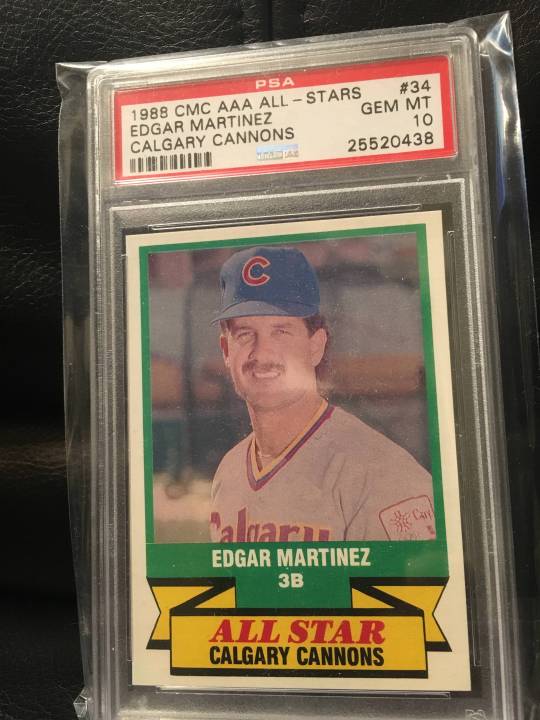
I’d been wanting an Edgar Martinez card for a long time. He has no rookie card that really looks great though. This was my favorite of the bunch I had seen.
Edgar is one of the best designated hitters ever. Not the best, but at least top 3. Deserves to be in the hall, and I’m glad he’s taken a big jump in the votes and looks like he could get in next year!
05.) 1978 Burger King Tigers #013 - Lou Whitaker (PSA 8)

I had a PSA 8.5 of Alan Trammell. You can’t have just Trammell though without Whitaker. For 19 years, those 2 were the starting 2B and SS for the Detroit Tigers, and they were damn good. Trammell & Morris just made the Hall of Fame thanks to the Veterans Committee, but left Whitaker off the ballot in a decision that was just baffling. Hopefully Whitaker gets his due soon enough. He’s arguably the best of those 3.
06.) 1995 Upper Deck SP Top Prospects #011 - Carlos Beltran (BGS 9.5)
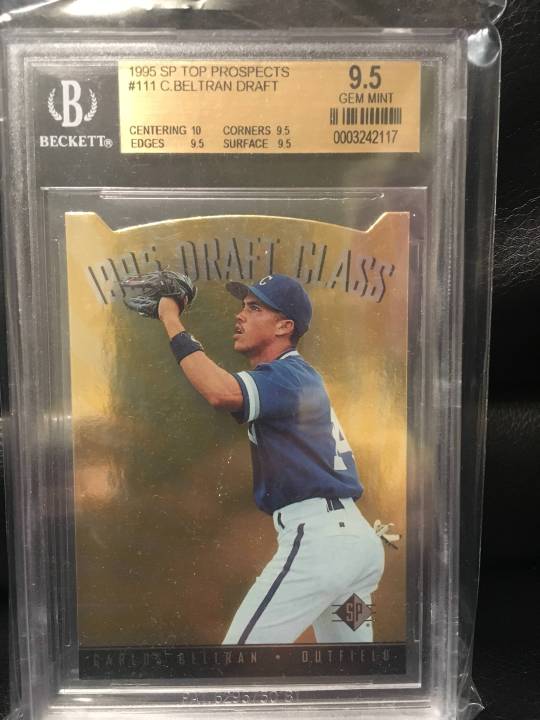
Carlossss!!! The very next day after I purchased a Lou Whitaker, I got this card. No real reason other than I really like Beltran. I don’t think he’ll ever get Hall of Fame votes or anything, but he was a big player in New York.
I don’t like the Astros, but I’m glad he finally got his WS Ring before retirement.
07.) 1998 Bowman’s Best #120 - Adrian Beltre (BGS 9.5, AUTO 10)

This is it. The biggest purchase I made this year, and by far the most I’ve ever spent on a single card. A tough grade on its own, but I managed to get one with the Topps Certified Auto as well!
I got this card in March. Beltre went into the season with 58 more hits to go before he reached a career milestone of 3000. He ended up going into the season with an injury that kept him out for a little less than half the season. Because of that, I was super worried he wasn’t going to come into the season very productive - but in 94 games he was still able to hit .312/.383/.532 and reach the 3000 hit mark.
He’s currently sitting on 462 Home Runs also. With only one more year left on his Rangers contract, I don’t know if he’s going to be able to make it to 500 before his career his up. But who knows, if he has another stellar year this year - maybe he’ll get signed to a few more years and hit just enough to reach another milestone.
I may have spent a lot on this guy, but I can see the value of it being much higher in the future.
08.) 2011 Heroes & Prospects #GSA2 - Gary Sanchez (BGS 9.5, AUTO 10)
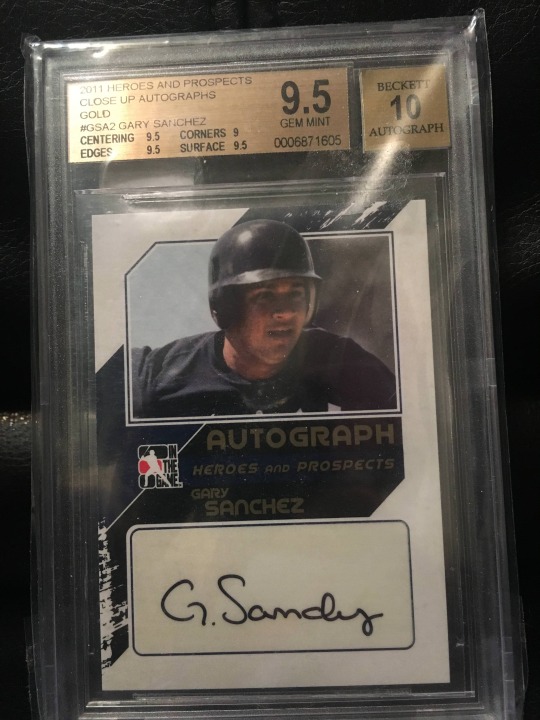
El Gary.
Gary Sanchez rolled into the 2016 season late and in only 53 games put up a really compelling case for Rookie of the Year. Unfortunately he didn’t get it.
Gary wasn’t as GODLY in 2017 as he was at the end of 2016, but he showed some real big sparks of greatness and I think he’ll be incredibly fun to watch for years to come.
This card is the GOLD Version of this set. Only 10 of these exist. Only 2 have been graded a 9.5. I’m happy to have one.
09.) 2000 SPx #094 - Alfonso Soriano (PSA 10)

Alfonso Soriano came up as a 2nd Baseman on the New York Yankees. In 2002 and 2003 he mashed a lot of taters. We then traded him for Alex Rodriguez.
Soriano spent most of his career on the Chicago Cubs where he was... pretty mediocre. He hit dingers but didn’t get on base a ton. He ended his career with over 2000 hits and over 400 home runs. I thought he was fun.
10.) 1983 Topps #083 - Ryne Sandberg (BGS 9.5)

Ryne Sandberg played his career on the Chicago Cubs as a second baseman. He was really good. He could hit dingers and also defend really well.
A PSA 10 of this card cost over 300. Nutty. I ended up settling for a BGS 9.5 since I was able to get it for much cheaper. If PSA did raw grade reviews I might see if I could get it converted to a PSA 10... but they don’t. Hrm. Oh well!
11.) 1959 Menko #JCM14b - Shigeo Nagashima (PSA 7, HAND CUT)

This is the coolest card I got all year.
Shigeo Nagashima is the most popular player in the history of Japanese baseball. More popular than his teammate Sadaharu Oh, the Home Run King. This isn’t a rookie card unfortunately! It’s a second year card. However I got it because last year I was able to nab a Sadaharu Oh rookie from this exact same set! Put them next to each other, and they match very well. A rookie card of Nagashima would be really cool - but I’m really really happy with this one!
12.) 2013 Elite Extra Edition #071 - Gleyber Torres (BGS 9.5, AUTO 10)
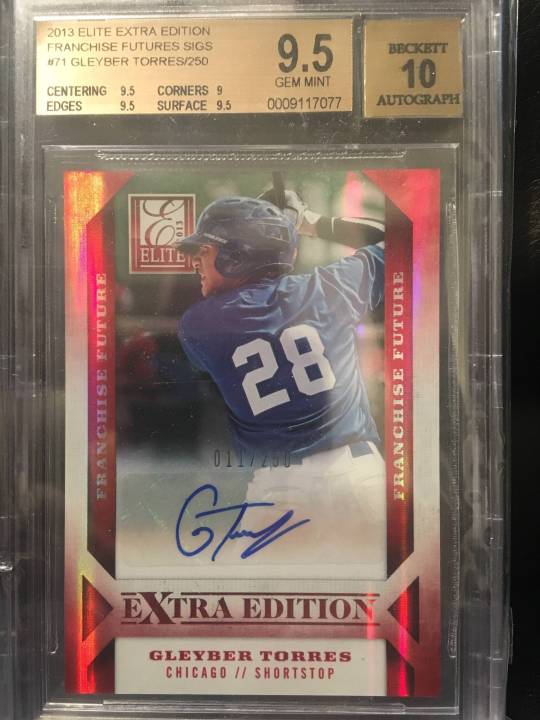
Gleyber Torres will be on the Yankees this year. Gleyber Torres will be great. I am ready for The Yankees to win the World Series.
13.) 2016 Bowman’s Best #B16ARO - Amed Rosario (BGS 10, AUTO 10)

The Mets had a million problems last year and it took them forever before they called up Amed. He wasn’t great, but he’s young and has a good shot to bounce back. At least I hope. Also, that’s a sick auto.
14.) 1978 Burger King Tigers #015 - Alan Trammell (PSA 9)

I already had a PSA 8.5 of Alan Trammell. But I wanted a higher grade. So I got this one!
15.) 1987 Leaf #043 - Rafael Palmeiro (PSA 10)

Rafael Palmeiro was a very talented player. He was a lock for the Hall of Fame. But then he did something very dumb.
His downfall came when he testified to a room of Congressmen that he had never used Steroids, and then only 6 weeks later he failed a drug test.
He was a lock for the Hall of Fame. But the announcement that he failed a test killed his good standing with fans. Despite being 1 of only 5 players to have 3000 hits and over 500 Home Runs, he fell off the Hall of Fame ballot on his 4th year with only 4.4% of people voting for him.
16.) 1993 Upper Deck SP #273 - Johnny Damon (PSA 10)
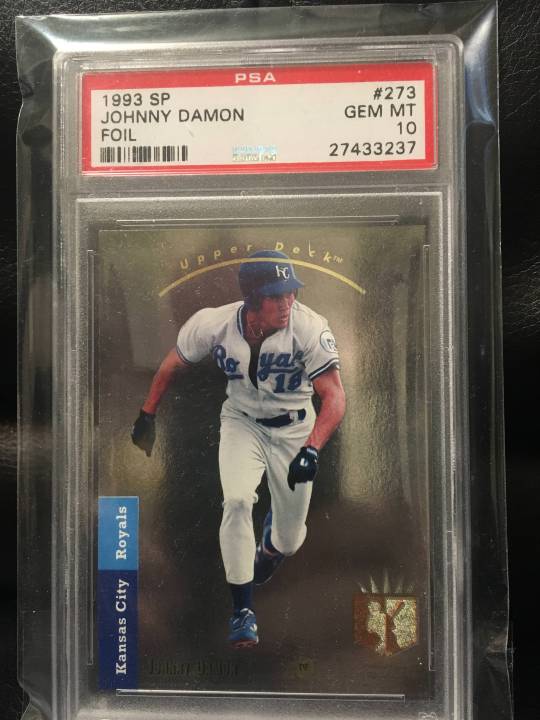
Johnny Damon was a good player. Not great, but very good for a long time. This was his best moment. He never did anything big on the Red Sox, no siree.
17.) Some Didi Gregorius

The Bowman with the facsimile is a rookie card. The card next to that has a real autograph! Both of these cards came with the purchase of an autographed ticket from Didi Gregorius’ first game in Yankee Stadium. He hit a home run on the first pitch he saw.

18.) 2014 Sal Top Prospects #017 - Aaron Judge (JSA AUTO)
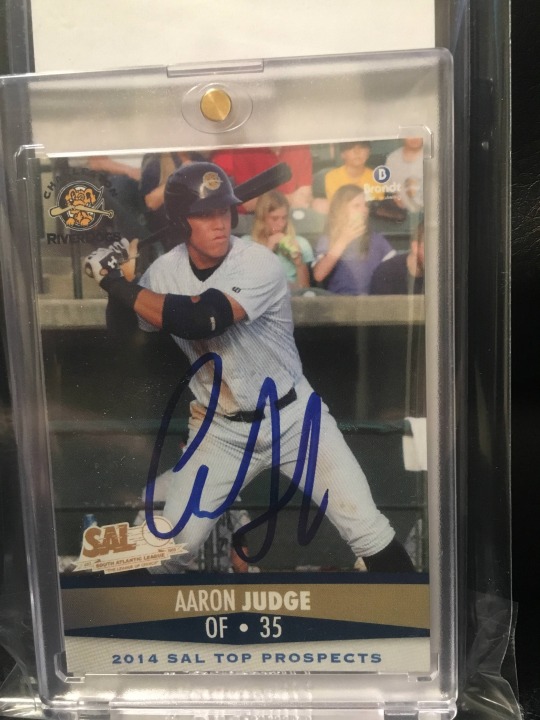
Aaron Judge is big, and strong, and also my friend. I don’t think this card is really in the best condition to be graded, which is why I haven’t done that yet - but I really like the photo and the Autograph. You can tell he’s a big boy. I like it very much.
19.) 2010 Bowman Sterling #025 - Carlos Santana (BGS 9.5, AUTO 10)
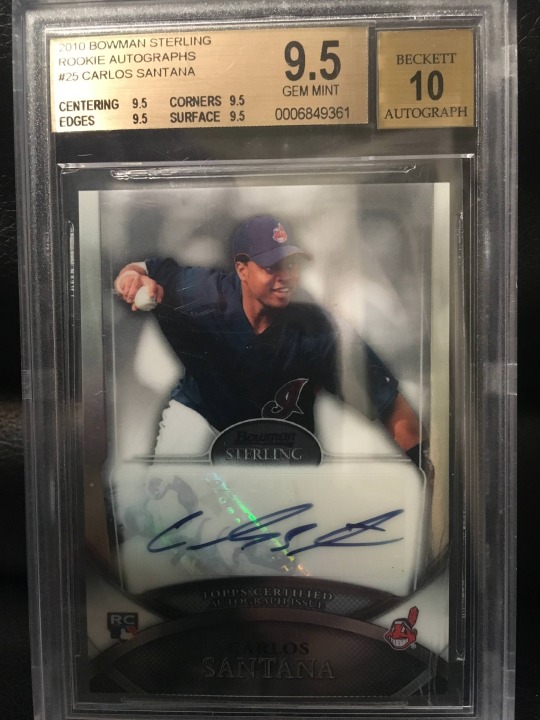
Not his biggest card or anything - but for a First Baseman who has been nothing but good his entire career, this card was cheap as hell. Not one of my favorite players, but deal was a bit too good to pass up.
20.) 2003 Upper Deck USA Baseball #J-5 - Justin Verlander (PSA 10)

I don’t think I’d have been able to get this card for this cheap had Verlander not been on the Tigers still. One of the better pitchers of this era, and while he looked to be falling apart in 2014 - he’s been great every year after. Probably only needs a couple more good-not-great years and he’s pretty much a lock for the Hall.
21.) 2005 Upper Deck USA Baseball #DB-GU - Dellin Betances

A throw in with another card I had purchased. I forget which. I hope Betances can bounce back after falling apart last year because he is very fun when he is striking out everybody.
22.) 2008 Upper Deck USA Baseball #QA-SS - Stephen Strasburg (BGS 8.5, AUTO 10)

Aaaaugh!!! The 8.5 on this card KILLS ME. But despite that, I’m happy to have it. Strasburg was one of only 2 big current players on my list when I first started collecting cards again over 5 years ago. His popularity and scouting reports which pretty much guaranteed he was going to be a huge star made all of his cards wayyyyy out of my price range.
Strasburg is still a very popular player, and still very good. In 2015 & 2016 he wasn’t able to get any more than 150 IP though. Take that and add in that his ERA had been steadily climbing with each year, and this card became affordable.
However, in 2017, Strasburg had a real bounceback year. 175 Innings Pitched, and an ERA of 2.52 in a year where offense was the highlight.
I may just get this encased with a grade for the Autograph. I really love the rarity of this card. Only 20 in existence, great autograph, and it spells his name wrong. A lot to like!
23.) 2010 Upper Deck USA Baseball #USA-62 - Corey Seager (JSA AUTO)

This was a throw in if I added 10 dollars to the Strasburg card. Corey Seager is the starting shortstop for the LA Dodgers. He’s really damn good, and will probably be good for at least another 10 years.
24.) 2008 Bowman Chrome #BDP48 - David Robertson

DEALIN’ DAVE IS BACK ON THE YANKS. I love him. I’m planning to get it slabbed very very soon. That is all.
25.) 2010 Bowman AFLAC #FL - Francisco Lindor (BGS 9.5, AUTO 10)
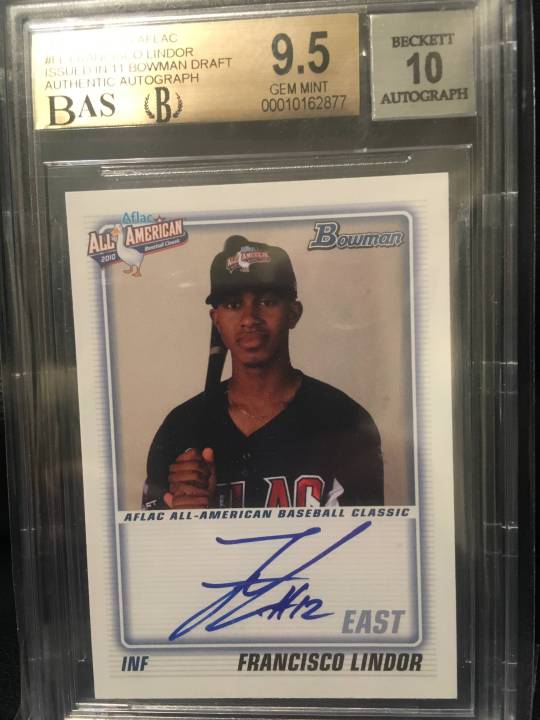
Francisco Lindor had a rough start to the year, hitting only .252/.312/.456 in the first half. That’s rough when you supposedly had turned down an 100 million dollar offer at the start of the year.
However, he bounced back in the second half hitting .298/.366/.563. Like Corey Seager, he’s probably going to be a great player for years to come.
I don’t think I got as good a deal on this card as I did on the Joey Votto that I bought at the end of last year - but for the price I got for it... it’s gotta be up there. A really great way to end the year!
Andddd that was the last one! Hope you enjoyed.
#Baseball Cards#Baseball#MLB#NPB#Topps#Bowman#Leaf#Donruss#Upper Deck#Burger King#Panini#Prospects#Rookies#Menko#Shigeo Nagashima#Lou Whitaker#Alan Trammell#Jose Canseco#Ryne Sandberg#Rafael Palmeiro#Curt Schilling#Edgar Martinez#Johnny Damon#Carlos Beltran#Adrian Beltre#Alfonso Soriano#Justin Verlander#Dellin Betances#David Robertson#Stephen Strasburg
0 notes
Text
How a white supremacist learned to leave hatred behind
December 23, 2017 | 10:16pm | Updated December 23, 2017 | 11:01pm Christian Picciolini had gone to sleep just after midnight when a noise outside his window woke him up. The 17-year-old had started many fights and beaten up a lot of black people, anti-racists — pretty much anyone who wasn’t just like him. He had also recently acquired an arsenal, including an AK-47, a 9mm pistol, a rifle and a sawed-off shotgun. Thinking one of his victims was out for revenge, he grabbed the shotgun. Taking a deep breath, he put his finger on the trigger, flung open the curtain, and found himself pointing the barrel directly into the face of his mother. “She sank down into the bushes weeping and quivering,” he writes. “‘Why do you have a gun? What life are you living?’” Piccolini was living a life of violence and destruction, he writes in his new memoir, “White American Youth” (Hachette Books), out Tuesday. Between the ages of 14 and 22, he was first a member, then a leader, of the white power movement in America, spreading the white supremacist and Nazi doctrine, and hurting anyone who disagreed with him. Picciolini was born in Chicago in 1973 and grew up bouncing between the suburb of Oak Forest and town of Blue Island, Ill. His parents, both hairdressers, were recent immigrants from Italy who worked long hours, leaving him with his grandparents during the day. He would later blame his embrace of hate groups and violence on his feelings of abandonment. Relentlessly bullied in school, the one bright spot in his childhood was the birth of his brother, Alex, in 1983. “When my mother came home from the hospital with Alex, my heart swelled with pride,” he writes. “It was as if I’d known him my entire ten-year life. He was a part of me, and I was a part of him.” The two played together all the time. When Alex was two, Picciolini gave him a doll called My Buddy. From that day forth, the two called each other “Buddy.” “Buddy filled a huge void in my life,” he writes. “I felt I had a family member who wanted to spend time with me.” Picciolini was 14 when he met Clark Martell, the 26-year-old founder of Chicago Area Skinheads (CASH), the “first organized white-power skinhead crew in the United States.” Picciolini was smoking a joint with a friend when Martell, emerging from a car, stormed over to him, grabbed the joint and stomped it out. “Don’t you know that’s exactly what the Communists and Jews want you to do, so they can keep you docile?” he said. Martell then launched into a speech about Picciolini’s regal ancestry and the greatness of Roman warriors, especially Centurions. He wrote “Centurion” on a piece of paper, instructed Picciolini to research it, then told him to “come find me and tell me what you’ve learned about yourself and your glorious people.” Picciolini saw Martell as the first adult to discipline him for good reason — the first to care. He swore off weed and hung around Martell every chance he got. He absorbed his beliefs as well as his fashion sense, dressing in Doc Marten boots and suspenders and shaving his head. But in early 1988, Martell was arrested for beating a woman who had left his group and was sentenced to 11 years in prison. Picciolini never saw his mentor again, but he was lured in even more by the danger of the scene’s criminal element. As he went to racist rallies and concerts, developing a love of white supremacist music and its teachings, he noticed that Martell’s absence created a void. Without a leader, the gatherings usually erupted into beer-fueled chaos and infighting. At just 15, Picciolini decided to fill that void. He rented a post office box and began communicating with skinhead, Nazi and racist groups across the country. When one group sent him a piece of white power literature, he immediately copied it and sent it to other groups, becoming a conduit for white supremacists nationwide. “I missed no opportunity,” he writes, “to market the ideology of white supremacy.” He also embraced violence, seeking out fights. In school, when a black student deliberately bumped him, he split open the student’s nose with his fist and slammed his head into the steel doors of the school’s lockers. After he was expelled, he returned and spray-painted ‘Ni–ers Go Home’ in two-foot-high white letters across the school’s front doors, he writes in the book. Life at home, meanwhile, grew tense. His mother started snooping through his things and found a T-shirt emblazoned with a swastika, which led to a horrible screaming match. His mom brought in Buddy, then 6, to try to appeal to Picciolini’s warmer side, but her older son slammed the door shut. When he heard further knocking, he threw the door open and screamed, infuriated, “Leave me the f–k alone and stay the hell out of here!” Christian and Buddy But it wasn’t his mother knocking. It was Buddy. Picciolini tried to comfort him, but Buddy ran away sobbing. As Picciolini burrowed deeper into white supremacy, he distanced himself from his beloved brother, treating him as a nuisance and pushing him away. A leader in the movement by 17, Picciolini formed a white power band of his own. First called White American Youth (WAY), then Final Solution, they became the first American white power band to play in Germany. That same year, Picciolini met Lisa, a “nice little Irish Catholic girl” and a non-racist, through school friends. Aware of Picciolini’s reputation and disliking his views, she nevertheless fell for the charismatic and good looking teen. Making out in his car early on, she noticed the shadow of a swastika etched into the condensation of his car window. “Can I ask you something?” she said. “Of course,” he replied. “Why do you have so much hate inside you?” she asked. Caught off guard, he lied. “I don’t hate anyone,” he said. “I just love what I stand for so much that I’m willing to protect it from those who want to do it harm.” “I knew my answer was bullshit,” he writes. “It was a common practice within the movement to always spin our hateful agenda and wrap it up in a pretty little ‘white pride’ bow for the general public to consume. The truth was, we hated everyone who wasn’t like us.” Still, Lisa probed deeper. “But then why aren’t you doing anything positive,” she replied. “All you do is say such horrible things and get in horrible fights and hurt people. When you’re with me, you’re so caring and gentle, but all I can wonder is, which one is the real you?” Over time, Picciolini kept his racist activities out of her sight, and her feelings for him overrode any sense of disgust or confusion. Picciolini proposed marriage in December 1991, just after his 18th birthday, and they were married the following June. They moved into their own apartment and had two sons in short order, with Picciolini working full time at a pizza place to support the family. Meanwhile, he began to have doubts — “the first rational thoughts I’d allowed myself in years,” he calls them — about the movement. In September 1992, he attended a massive white power rally in Pulaski, Tenn., that drew far more counter-protestors than participants. The protestors reminded him of people from his past, including one friend’s gay brother and some black schoolmates, people who had treated him well. “I suddenly felt guilty and out of sorts,” he writes. “I was starting to question what this struggle was about.” In an effort to better support his family, he opened a record store selling white power punk. But these bands weren’t plentiful or popular enough to sustain the store, so he also stocked anti-racist punk and other music as well. “This was a legitimate business, after all,” he writes. “I needed a diverse inventory that would bring paying customers.” He was shocked to see the same anti-racist punkers he used to feud with enter his store and buy music from him. Some even became loyal customers. One day a man he called “Black Sammy” came into the store with “three of his minions.” Sammy was the co-founder of a local anti-racist skinhead group called Skinheads of Chicago and the sight of him left Picciolini shaken. “My blood froze when I saw him in the doorway,” Picciolini writes. “We held each other’s stares for a territorially awkward fifteen seconds.” Sammy had formed his group in direct opposition to Martell’s. “I think you might be in the wrong place, Sammy,” Picciolini replied, his hand “hovering behind my back, near my [9mm].” After an awkward back and forth, Sammy asked about a few bands. Picciolini said he didn’t want any trouble. Sammy asked if he took credit cards and the tension slowly dissolved when they began discussing the actual music. Thirty minutes later, Sammy and his friends spent over $300 on records, making it Picciolini’s largest sale to date. “Before I knew it, we were shaking hands, and a bizarre smile was forming on my face,” Picciolini writes. “What could I say? The ideological delusions that had led me so far astray were crumbling right before my eyes.” Over time, his racist beliefs were no match for his everyday reality, which found him interacting with a diverse assortment of people on a daily basis. He stopped selling white power music in the store and no longer considered himself an activist for the cause. But a white power concert in Wisconsin in August 1994 was the final straw. Less than an hour after it ended, an acquaintance he’d spoken to at the show was murdered in “a skirmish with black youths.” “I could no longer deny my growing disgust with this miserable existence I’d created,” he writes. “This life wasn’t for me anymore.” Still, certain parts of his life couldn’t survive his past. He and Lisa, fighting constantly, divorced when his second son was four months old. He moved back to his parents’ basement, but Buddy, now 11, ignored him. Any warmth between them was gone. Picciolini decided to rebuild his life. He got a temp job at IBM, which after a year and a half, became a full-time position in marketing and operations. Meanwhile, he used IBM’s tuition assistance program to attend DePaul University, where he got a degree in international business and international relations in 2005. Christian Picciolini in 2017AP His IBM colleagues never learned about his past, but he told his story for the first time publicly in 2002 while at DePaul. “I did it as part of an essay that I read aloud to [a] class,” he wrote in an email to The Post. “I broke down sobbing during it.” He expanded that essay into a graduate thesis, which became the first draft of this book. In 2009, he co-founded Life After Hate, an organization dedicated to helping people leave white supremacy. He participated in interventions, won an Emmy award for a PSA he produced for the group and left the organization earlier this year to focus on “building a global extremist intervention network for all types of extremism.” He and Lisa remained friends, and he is active in the lives of his sons, now 23 and 25. In 2002, he began a romantic relationship with a woman named Britton who worked in a different division of IBM, and they married in 2005. He also made peace with his parents, apologizing for the years of trouble and grief he caused them. One relationship, however, could not be repaired. Buddy grew into an angry teen. He drank, hung out with street gangs, and was arrested for marijuana and gun possession around 2001 or 2002. Offered community service, he demanded jail time instead, “to prove he was tougher than me,” Picciolini writes. He tried to talk to Buddy about his choices, but his own actions had removed any authority he might have had. “Who the f–k are you to tell me what to do? It’s not like you even remembered I existed until now,” Buddy countered. Buddy added another crushing blow. “My name is Alex,” he said. “I ain’t your buddy.” A year later, while driving around with a friend looking for weed one night, Alex was mistaken for members of a gang’s rivals and shot twice in the passenger seat, with one bullet hitting him in the femoral artery. He died just one month shy of his 21st birthday. Picciolini, now 44, still blames himself for Alex’s death. “I felt that his death was divine retribution for all the violence and hate I’d projected into the world,” Piccolini writes, “for the pain I’d inflicted on others for the color of their skin, and my misplaced idea that by hurting them, I could save myself.” Share this: Source http://www.anglenews.com/how-a-white-supremacist-learned-to-leave-hatred-behind/
0 notes
Text
London delivery startup Doddle is closing most of its stores after burning through tens of millions of pounds
London delivery startup Doddle is closing most of its high street stores after burning through tens of millions of pounds in investment funding.
The company is laying off more than 100 people as it pivots its business model.
In 2015 it lost £24 million ($31 million) on just £687,000 ($878,000) in revenue, across dozens of stores.
Investors have sunk about £48 million ($61 million) into the company.
In August 2015, Doddle enlisted James Heptonstall, who creates viral videos of runners racing against public transport, to help the logistics startup launch a new feature — "Doddle Runner." With a tap of the Doddle Runner button in the Doddle app, customers could have their mail sent from any location via a human who would run through crowded city streets. No need to leave your house or workplace to visit the post office. A Doddle Runner would show up anywhere, like an on-demand competitor to the Royal Mail.
In the launch stunt, Heptonstall, on foot, raced three other people to deliver a package the short distance from Monument to Cannon Street during rush hour in London. One rode a bike, one went on a bus, and another took the London Underground. The whole thing was filmed for a YouTube video.
Heptonstall won easily — with a time of 1 minute and 23 seconds — in an apparent demonstration of the efficiency of runners in getting round London. The Tube user came second at 2:48, the cyclist came in third, with 3:32, and the bus was last, with a miserable 8:09 time.
But when Doddle Runner launched in real life, there was a catch: The runners weren't actually allowed to run.
"For health and safety reasons they're not allowed to run," Doddle CEO Tim Robinson told Business Insider. "They can walk briskly, is how we described it."
"To be fair, I think the most valuable thing they had is an Oyster card," he added, referring to London's ubiquitous public transport pass. "They spent most of their time on the bus."
Later that year, Doddle said it planned to expand Doddle Runner to new cities but the service was discontinued in 2016. Robinson described it to Business Insider as a "pilot," and said that was "always the plan."
Meanwhile, the company is grappling with bigger issues.
The parcel delivery startup is closing 17 of its retail stores across the country — most of its remaining stores. It is laying off more than 100 employees, and pivoting its business. It is nowhere near being profitable.
In 2015, its first full year of operation, it lost more than £24 million ($31 million) — while pulling in less than £700,000 (£894,000) in revenue across dozens of stores.
"Lots of members see us as the new Post Office — although I'm not allowed to say that," Robinson told City AM in early 2016.
For a fee, customers can receive or send packages at the stores. Won't be at home to receive a delivery and can't get it sent to work? Just get it delivered to Doddle instead, where "parcelistas" will take care of it until you can collect it. As e-commerce has boomed over the last decade, so too has click-and-collect, and Doddle — with its brick-and-mortar high street stores — is one of the most visible proponents of the model.
But conversations with former employees, Robinson himself, and accounts filed with Companies House paint a picture of a company in transformation. The three-year-old business is spending huge sums, sinking deeply into debt, and generating comparatively little revenue. Doddle is now changing direction, shelving its ambitious retail strategy as it moves away from standalone high street stores and shifts its business into kiosks in existing stores in an attempt to cut costs.
"I think we haven't got everything right, but I think we've got enough right to build a sustainable business," Robinson said in an interview at the company's East London headquarters. "It's just a sustainable business whose ambition is slightly different to what it was two and a half years ago."
A brief history of Doddle
Doddle's stores are hard to miss. They're big, bold, and purple.
Dotted around train stations and British high streets, they're emblazoned with bright purple signage on the outside, and have a minimalist white-lilac-purple design within.
Doddle was the idea of Tim Robinson, now the CEO. His original vision was to launch Doddle's stores in under-utilised spaces in or nearby rail stations across the UK. Stations, with heavy footfall, are an ideal place to pick up a package on your way to or from work, the logic went.
The company was launched as a joint venture between Network Rail and Lloyd Dorfman, the billionaire founder of Travelex, a currency exchange company best known for servicing tourists at airports. They initially invested £24 million between them, split equally, Robinson said. Their aim was to change how people send and receive parcels with a chain of high-profile high street stores.
There were plans to open stores at 300 stations, Sky News reported in 2014. But three years later only a sixth of that total are actually open — 57 shops, including concession desks inside larger stores. Just six are standalone stores. 17 sites are facing imminent closure.
So what happened?
From relatively early, Doddle faced difficulties enticing people into stores. "What we're finding is consumers are not prepared to walk far off the beaten track to collect their parcels," CEO Tim Robinson told the BBC in July 2015. "I think some of the assumptions we had in our original business model that we could be 100 yards to the right outside a railway station have not really played out."
Network Rail withdrew from the business in the Autumn of 2015, The Times of London reported at the time. The move was part of a broader sell-off of assets by the rail organisation after it was effectively renationalised by the UK government. (It is also selling off at least 18 stations.)
Dorfman, who serves as Doddle's chairman, bought out Network Rail's 44% stake for an undisclosed amount — giving him 90% of the company overall.
While the focus was on train stations, some stores were located nearby, rather than inside the station itself. "We learnt that it wasn't just railway stations that our services really worked in," the chief exec said to City AM in January 2016. "We've got six stores in universities now. Shopping centres work well … we'll have over 300 stores by 2017, but not all in railway stations."
"As you get further out into the provinces it's harder to find 1,500 sq ft on a railway station, so we look for retail units that are right in the eye-line," he also told Essential Retail. "We're either in the station or adjacent to it — within and around stations."
Doddle is hemorrhaging cash
Doddle's public accounts from this time show the company generated very little revenue compared to its losses.
Doddle officially started trading in September 2014, and in the year ending December 21, 2014, it lost just under £11 million. During the same period, it booked just £16,779 in revenue.
In other words, in its first three months the business made less than the annual salary of a single employee working a 40-hour week on minimum wage (£6.50/hour in 2014, or £17,280/year). Doddle had 43 locations in operation during the period, according to its accounts.
Doddle's revenues grew in 2015, the most recent year accounts are available for publicly, as did its losses. The company lost £24.4 million throughout the year, with revenues of just £687,505. That means the 56 locations it operated were generating, on average, just over £12,000 each annually — less than the salary of a single full-time employee.
Meanwhile, the company was spending £8 million a year on staffing costs for its 336 staff.
Doddle's accounts for 2016 aren't public, but Robinson said revenue grew by slightly more than 200% year-on-year, while losses "shrunk a bit." (A spokesperson later declined to provide exact figures.) If we estimate revenues at £2.5 million and losses at around £18 million, that would mean the 70-odd locations (both shops and concession stands) Doddle was operating at the end of the year were still only pulling in around £35,000 each, not nearly enough to cover losses.
Robinson said that the company always expected to lose money when it started out, describing Doddle as a "growth business."
Dorfman's cash is keeping the company afloat, and since the initial £24 million Network Rail/Dorfman investment, he has invested "kind of similar to the same again," Robinson said, which would put the total invested at about £48 million. The company owes him at least £16 million, according to Companies House documents.
A former retail manager said staff spent hours waiting with no customers in the early days of the business, though it grew rapidly throughout their time there. And a negative review of the company posted on job review site Glassdoor in November 2016 said they had "plenty of time to look for other jobs as we have hardly any customers ... our store barely takes enough to turn the lights on." (The company is rated 2.4 out of 5 on the site, with ratings dropping recently.)
The manager Business Insider spoke to questioned whether the standalone high street model could ever be viable: "It doesn't take a genius honestly. When you see a store in a premium location, and the rent can be £100,000, and there are five staff inside on average 22 to 25 [thousand] per annum, minus the manager, it's easy to understand that this particular store costs pretty much near a quarter of a million ... you need to make stellar, unrealistic sales in terms of collections, returns, etc etc."
Later, the source added: "I think they always knew they're not gonna make any money for the first one, two, three years of the operation. The most important part was to make ourselves known."
Doddle is happy to experiment — but not always successfully
The company was willing to take an experimental approach to new ideas and products, and was "happy to try new things," former staff said.
Some stores have changing rooms, where customers can try on clothes they ordered online, and send them back if they don't like them. However, they were only used "handfuls of times," Robinson said. One store had fridges storing alcoholic drinks for a trial by AB Inbev that sold drinks via Deliveroo.
Doddle Runner was an example of this experimentation. Couriers on foot were assigned to stores, delivering and collecting parcels in the surrounding area. It launched in the City of London in 2015, with a press release from the time saying it would later "roll out across London and major cities." However, it was discontinued in 2016. A Doddle employee said that "uptake was minimal" during their time at the company.
Robinson said that Doddle is in talks with online retailers about "lighting that up again" — but integrating it into the online checkout process, so customers would have the option to order parcels to their desk when they buy them.
Doddle Neighbour was another experiment. The project tried to turn ordinary people into collection points, allowing you to get parcels delivered to your neighbours rather than a physical store. But Doddle struggled to find people willing to become a "Neighbour," and the feature is no longer available.
Click-and-collect is hot right now — but competitive
Doddle is looking for other sources of revenue beyond walk-in customers and one-off orders. It has deals with companies like ASOS and Amazon for deliveries and collections. And Doddle has been selling itself to big companies as a kind of outsourced post room for their employees. Goldman Sachs is among the clients.
Individual customers can also sign up as "Doddle Unlimited" members, giving them unlimited collections and 10% off sends for a monthly fee. (Including the free tier, Doddle has 350,000 members, but just 6,000 are "Unlimited" members, according to the CEO.)
Click-and-collect is a fast-growing niche in e-commerce, with shoppers expected to pick up £6.5 billion from places that offer the service by 2018, according to Verdict Research. Numerous high street chains, from Tesco to John Lewis, now offer the service — and there are third-party click-and-collect services also giving Doddle stiff competition.
One of the largest is Collect Plus, a parcel-sending-and-collecting-network in more than 6,000 locations across the county. Unlike Doddle, it doesn't operate its own stores. Instead, it piggybacks on other retail locations, enlisting newsagents, garages, shops and more to handle the parcels in exchange for a fee — drastically cutting costs.
From a financial perspective, Doddle is a minnow next to Collect Plus, which did £49.6 million in revenue in the year ending March 2016 — while losing £447,783.
Online retail behemoth Amazon is also placing "lockers" into shops that customers can order their parcels to. (Some Doddle stores contain Amazon lockers.) And catalogue retailer Argos is also partnering with companies like online auction site Ebay to let customers collect orders from their stores in a similar fashion.
Doddle has historically been at a disadvantage against these companies. For organisations like Argos, or the corner shops working with Collect Plus, click-and-collect is just one additional revenue stream among many others. It can be used as a loss-leader to keep customers coming back for other services. And Collect Plus and Amazon don't have to worry about expensive high street rental or retail staff costs like Doddle does. But Doddle has all those challenges, and deliveries are its only revenue source.
Core customer loyalty is no longer enough
Joe Rackham, a TV production manager who lives in Putney, South London, said Doddle was invaluable as he planned his wedding in 2016."It's been a godsend for us to be honest, we would have really struggled to accumulate everything we needed to buy for our wedding without a service like Doddle."
He added: "Before Doddle we had been so used to arriving home to a missed delivery card from couriers who would then expect us to travel out to the middle of nowhere to pick up packages from a depot with opening hours that were never convenient. The staff at Doddle have always been really friendly and helpful, so it's sad for them also that many of them will be losing their jobs as a result of these closures."
Rackham is typical of Doddle's core base of loyal customers. Robinson has said in interviews that a subset of Doddle customers will come time and time again, becoming extremely regular users of the service, and an ex-manager said their team made a point of remembering the names of these regulars.
But when you're renting some of the most prime real estate in the country, a small and devoted following isn't enough. Tens of millions in the red, Doddle is finally realising that.
Doddle is closing most of its stores and pivoting
At launch, Doddle wanted to build 300 stores within three years. In February 2015, Essential Retail reported it was aiming for 100 stores by the end of 2015. And at the start of 2016, Robinson said the company would have "well over 300 stores by 2017."
But at its peak, Doddle had just 39 standalone retail stores, in addition to concession desks inside larger retailers. A former Doddle employee said they were told Doddle had met its parcel targets for 2015 and 2016 — but the company is now closing most of its stores and laying off staff as it pivots to a concession desk-model.
It has quietly been closing stores, a few at a time, since 2016. One employee laid off when their store closed earlier in 2017 told Business Insider the closure came as a shock, as employees had previously been assured that it was not at risk and had met its targets.
But the imminent closures are its largest single batch to date — 17 stores, from Milton Keynes to Kingston, are being shuttered on April 28. "The reality is that shop [in Milton Keynes] has been open for two and a half years, it has had a decent amount of money spent on it," Robinson said. "We'd capped out at about 250 transactions a day, we were struggling to get any more than that and for that store to work it'd need about four-to-five-hundred."
Just six high-street stores will remain, including Liverpool Street Station and Finsbury Park, along with two standalone kiosks in Westfields, London. ("A couple" of the remaining stores are profitable, the CEO said.)
102 people are losing their jobs in this batch of closures — retail employees, as well as "head office functions that are no longer needed because we're not supporting the store network," Robinson said, and cuts across other departments "to make the business more fit and lean for the future."
Instead, the company is focusing on concession desks and kiosks inside larger stores, largely inside Morrisons supermarkets, Ryman stationers, and Cancer Research UK charity stores, dotted from Glasgow to Brighton. Instead of an entire dedicated store, a Doddle location becomes a single desk, like Collect Plus.
Robinson said that the company's partners like Amazon and ASOS want to see it in more locations, hence the shift. "It's clearly about efficiency and productivity, so in order to satisfy the demands of our retail partners to get more sites, to become more present, we've had to rethink how we spend our working capital."
Doddle has an ambitious roll-out planned, aiming to be in kiosk 500 locations by the end of 2017, and 1,000 by the end of 2018. (A previous story in CloudPro reporting Doddle wanted to be in 1,000 stores by the end of 2017 is incorrect, Robinson said.)
The company is also now experimenting with selling white-label tech to other companies. "We're working with a number of high street retails, both domestically and internationally, and carriers, helping them set up their own click-and-collect networks using the tech we've built," Robinson said.
Doddle is also apparently in talks with a major retailer about the company adopting Doddle Neighbour's tech for their own deliveries — paying people to take in orders when the customer isn't available to collect it. "This is a retailer that has years of brand knowledge, and experience with people living in pretty much every house in the country ... this retailer has a loyalty base of several million."
This isn't an approach Doddle anticipated when it first launched, but in a few years, 30% of its revenue should come from white-label tech services, the chief executive predicted.
The CEO doesn't think the retail stores were a failure
The vast majority of kiosks and Doddle locations will be manned by the employees of the store its inside, which — along with the lack of expensive retail units — should significantly reduce costs. Tim Robinson estimates the company will do £5.5 million in revenue in 2017, and will become profitable in 2018.
Despite Doddle's losses, the exec argued that he doesn't consider the retail shops a failure, and that it couldn't have struck the deals it has with partners without the stores helping them "cut through."
"We wouldn't have been able to do this pivot if we hadn't done what we'd done previously. I mean, do I wish I'd had 10 fewer [stores], 15 fewer? Probably, particularly with what we're going through now, ultimately getting to that position where you're having to say goodbye to colleagues and locations you've put a lot of time and effort into."
The exec also suggested the company might return to standalone stores one day. "I've said to people a few times, 'what I might've done is build the click-and-collect network for 2022 but I built it in 2014' ... the idea might've been six, seven, 10 years ahead of its time."
Contact the author at [email protected]
Join the conversation about this story »
NOW WATCH: I won't trade in my iPhone for a Samsung Galaxy S8 — here's why
0 notes
Text
Spring Break Jackpot 2017, Phoenix & Sedona, AZ, 3/17/17 - 3/21/17
Trip #1 of 2017 is in the books, and this one goes down in the Hall of Fame for trips that we’ve been fortunate enough to experience. From the get-go, this trip had extraordinary written all over it – sun, fun and relaxation. A perfect spring break trifecta!
The Arizona trip kicked off on the first Friday of March Madness weekend – my most favorite sporting event of the year. Therefore, before we could start the vacation, we met Jeremy, Scott and Dave at the bar for some basketball and brews. We hung out at Lone Oak Grill for about 3 hours catching up and watching some hoops. Around 3:00, Dyan whisked me away to the airport so that we could get checked in for our 6PM flight.

At 5:30, we boarded the gigantic 767-300, the first wide body plane I have been on since my Dad took Josh and I to Las Vegas for my 21st birthday. Our seats were in the middle of the aircraft, so I didn’t get the window seat I had hoped for, but holy cow, this plan had freaking tv’s streaming live broadcasts! JACKPOT! As the jet taxied down the tarmac, I found the TNT feed, and tuned into the Jayhawks, UC Davis game, which at the time was a nail biter.
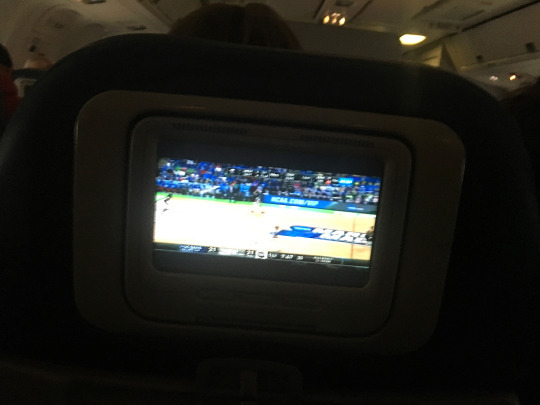
Two hours into the flight (from 32,000 feet) I watched the Jayhawks finish up a dominant performance! Best. Flight. Ever.
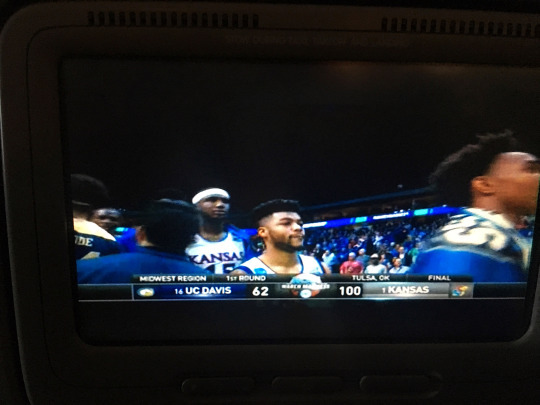
I was amazed at the technology inside the airplane. As if the in-flight tv broadcast wasn’t cool enough, the flight also had a real-time flight tracker which showed plane location, speed, altitude and arrival time among a whole bunch of other data. For the remaining 80 minutes of the flight, I geeked out on the gps mapping software. Such a cool feature for somebody like me who likes to find landmarks 30-some thousand feet below to find out exactly where I am in the sky! But all good things must come to an end, and we landed just after sunset in Phoenix.
Going into this trip, we knew the average temp in the Phoenix for this time of year was 77 degrees. When we walked out of the airport (in jeans and sweatshirts), we were greeted by what felt like a furnace! It was 92 degrees, and it was nighttime. But, coming from 30 degree Minnesota weather, it felt heavenly. We quickly made our way over to the car rental HQ and found out it was our lucky day.
About 3 months ago, I scoured the net looking for a reasonable price on a convertible Mustang or Camaro. I figured if we were going to be in a warm climate doing some road-tripping, we needed a fun car. Basically everybody going to Phoenix over spring break must have had the same idea, because convertible sports cars were running $500-1,000 for the 4 day rental. Geez! Feeling defeated, I tried a last ditch effort by downloading an app on my phone called “Carla.” The app claims to offer the best car rental rates available. After a quick 1 minute search for my specific trip, I found a deal through Alamo for a “Convertible Mustang, or SIMILAR” at $237. What? That can’t be right. Why is it so cheap? It seemed way too good to be true, but I had nothing to lose. JACKPOT! I booked by putting 10% down and the rest due at the rental counter. But we had a few headwinds working against us. In doing some research, I found that Alamo is notorious for giving people the “SIMILAR” car in the convertible class, which happens to be a Chrysler 200….not exactly a fun sports car.

I also came to the conclusion that since we were getting in late on a Friday evening, the good cars would be sold out from people upgrading their weekend rides. It was kind of like picking teams on the playground in elementary school. Everybody wanted the good looking sporty kids – they were always picked first. Nobody wanted the unsporty clunkers. I was keeping my fingers crossed I wouldn’t get stuck with a clunker.
While at the rental counter, there was some systems problems, which meant we got to bypass the line of customers and go to a special check-in counter. I must say, Alamo was fabulous, and check-in was a breeze. When I asked the representative if there was any Mustangs left, she opened the door to the lot and barked some orders to some of the guys working the lot. She came back over to the desk and said, “It’s your lucky day!” They had one more convertible Mustang left, but it was a 2017 Mustang GT with the 5.0L V8. JACKPOT! My reservation had been for a standard V6 Mustang convertible. Dyan and I threw our bags in the car as quick as we could. We wanted to get out of there before anybody realized they accidentally put us in an upgraded convertible! Maybe it wasn’t accidental, but the fact that they did not boast to us about an upgrade made us think we were getting away with a steal! The downside of the car is that it had a heavy cigarette smell from the previous driver. No worries for us though. We put the top down before we even got on the road – which rectified the problem immediately. We were driving in paradise!
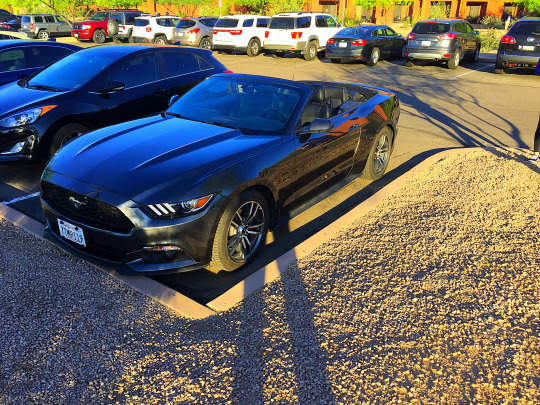
Around 9PM we pulled into the Sheraton Grand Wild Horse Pass Resort. This resort is way on the south end of Phoenix, in the booming suburb of Chandler. This would be a one night base camp only – which was unfortunate, because the property was amazing. The entire resort is decked out in Native American themed décor complete with flute & percussion inspired soft music and a four story waterfall. The moment we walked into the lobby, my blood pressure dropped. It was so peaceful and serene.

Being SPG Platinum members, we were upgraded to a mountain-view suite which also overlooked the amazing pool complex, golf course and lagoon. We enjoyed some southwestern tortilla soup around the outdoor bonfire before calling it quits for the night.
With our internal clocks still on central time, we woke up around 5AM local time. We made a few errands to Walmart, Starbucks and Krispy Kreme, and by 7:00 we decided to hit the Wild Horse Pass Casino before it got too smoky. It was here I got up close and personal with a gigantic cactus.

While standing by the cactus, I could hear the buffalo calling from inside!

Unfortunately, it was not our lucky day, but we always have fun playing Buffalo Stampede!

It was getting hot, so we headed back to the resort and spent a couple of hours wandering the resort’s nature trails and cooling off with a swim. The pool complex is amazing.

Perfect for families – multiple huge pools, a water slide, hot tubs and an outdoor restaurant. We discussed at length how this would make an amazing spring break resort for all seven of us.

The next leg of our trip was the one I had been most looking forward to! After checking out from the hotel, we took a 45 minute drive northwest to Surprise Arizona.

Dyan bought me 5th row tickets to the Royals/Indians spring training game. A few of the big name players were off playing in the World Baseball Classic (Duffy, Hosmer & Perez), but we did get to see Gordon, Moustakas and Cain.

The environment was so much different than watching a regular season game. The players were joking around on field and interacting with the fans during the game. Being that our seats were so close to the action, we could listen to the coaches talking to the players in the on-deck circle. It is such an amazing experience for a baseball enthusiast.

We had foot long hotdogs and peanuts for lunch and tried our hardest to buy some spring training souvenir hats, but they unfortunately were out of our sizes at all the shops in the stadium.
I am so lucky to have Dyan in my life. She treats me better than I ever thought was imaginable. She basically is the ultimate JACKPOT! It was so much fun sharing an experience like this with her – and having her seemingly enjoy it as much as I did! By the 8th inning, the Royals were losing 4-3, and the sun was blazing at 97 degrees. We had a long drive to Sedona ahead of us, so we bailed out of the game an inning early to beat the traffic. The Royals ended up hitting a game tying home run in the bottom of the 9th sending the game to an extra inning tie, 4-4.
The 2.5 hour drive north to Sedona was pretty as we transitioned from the desert (1,000 feet above sea level) into the mountains (4,000 feet). The best part of the drive is the final 15 minutes after exiting the interstate. The drive into Oak Creek (town just south of Sedona) was spectacular. Literally, the mountains changed from “normal mountains” to exquisite “red rock mountains” in a matter of a couple of miles. It is an area everybody should drive through once in their lifetime.
We were staying at the Hilton Red Rock Resort in Oak Creek. While the hotel is beautiful and the setting is amazing, the check-in process was a sign of the not-so-great experience that was yet to come.
For context, my work has a vacation saving program called Adestinn whereby Blue Cross will match 50% of the dollars I contribute to my vacation account. The account can then be used to book (Hilton/Hyatt) properties through the Adestinn website. To make a long story short, I had booked two separate reservations for Saturday and Sunday night because we wanted a room with a view of the red rock mountains, but that room was only available on Sunday. When checking in that Saturday night, Corbin informed us that the hotel was 100% full, and that he could not get us into the red rock view room for Saturday – which was okay with us since we had not pre-paid for the nicer room. Corbin did inform us we would need to change rooms the following day to the nicer room. We told Corbin we had a busy day the following day and would not be able to check into the new room until late in the day. Corbin and his manager confirmed our two night stay and got us all checked in to room 1020, which included a fantastic view of the parking lot. They assured us our view would be so much much better the following day.
After settling in, Dyan and I hit up the outdoor Jacuzzi for a quick soak before dinner. I was craving protein, so we headed into downtown Sedona to the Silver Saddle Cowboy Club, which is supposedly the best steakhouse in town. Dyan and I got seated and browsed the menu. Another couple was seated five minutes later adjacent to our table. After 20 minutes, we still had not had a server come by our table, although the table seated after us already had their drinks. We were famished, so we walked out of the restaurant in search of a restaurant we could get some service!
Right across the street was 89 Agave, a highly rated Latin inspired restaurant. We were seated immediately in the back of the restaurant in front of an 80” tv that was showing the UMD Bulldogs vs. UND Fighting Sioux playoff hockey game! Who would have thought? A Mexican restaurant 1,500 miles from home showing playoff college hockey. JACKPOT! We enjoyed a great meal of bottomless warm tortilla chips/salsa, chicken tortilla soup and beef enchiladas. I imagine it was as authentic as being in Mexico – minus the college hockey.
At dinner we also formalized our roadtrip for the following day. At the beginning of the conversation Dyan said she wasn’t very interested in visiting the Grand Canyon. But then the wind shifted directions. After a quick Google search of the canyon on her phone, she caught the idea of seeing the Grand Canyon at sunrise. Suddenly you’d think that was the entire reason for us coming to the area! Our drive was originally going to take us about 8 hours through northern Arizona. Now, not only were we going to be driving 8 hours, but three of those hours were going to come starting at 3AM so that we could get to the Grand Canyon in time for the sunrise…… We quickly departed dinner so we could get back to the hotel for some sleep.
3AM came quick. Too quick… We packed up, checked out of the room, and were on the road by 3:30. The drive should have been uneventful being that it was in the wee hours of the morning. However, it ended up being one of the most memorable experiences of the trip. Experience you say? Yes, experience.
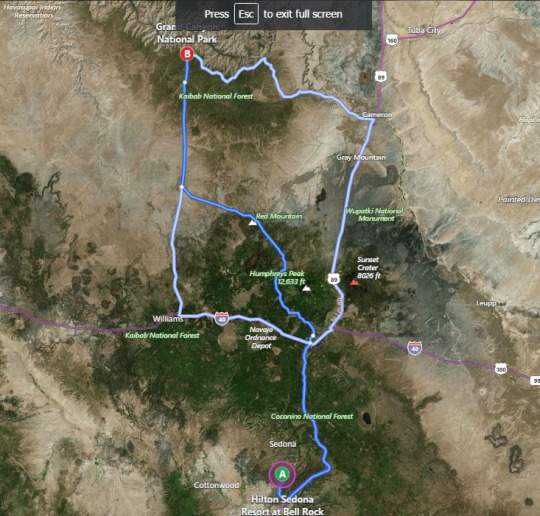
The GPS backtracked us toward the interstate before heading north to Flagstaff. It’s not too difficult getting carried away with a Mustang GT and before I knew it, we were pushing 80+ on I-17. About 10 miles outside of Flagstaff, we noticed a police car driving southbound with his spotlight pointed into the trees off of the highway. Clearly he was looking for something. About 1 mile later, I swerved to avoid hitting glass and plastic fragments all over the road. It was then I noticed a car had crashed into a shear rock wall on the right side of the road. The car was smoking badly, and I assume it had rolled on the highway leaving a trail of debris before careening into the rock wall. This crash had just happened, and it certainly looked like there could have been major injuries. We slowed so that we could call 911 to report the accident. As Dyan was dialing the phone, I noticed two elk on the shoulder of the interstate. As I began pointing it out to Dyan, she said, “it’s an entire heard of elk!” There must have been 30-40 elk just loitering in the field dimly lit by the moonlight. I had to wonder if the car hit or swerved to avoid hitting one of the elk. The 911 dispatcher got on the line and we reported the crash. She told me to maintain a safe distance from the crash because emergency responders were already nearing the scene - we relayed that the police car we had seen a mile back was looking in the wrong lane of traffic and needed to look on the northbound lane just before exit 322 at Munds Park.
That was a definite mood killer, and a wakeup call to a reality that we are in elk country, and should be driving much more cautious. Yikes. And little did we know, the drive would only get trickier from here. I am usually one to study maps, but since we only planned this excursion/route less than 8 hours ago, I never really had the chance to see what kind of terrain we’d be navigating. I assumed it was pretty much flat desert from Sedona to The Grand Canyon. Boy, was I wrong...
After passing through Flagstaff, the GPS put us on a little two lane highway in the middle of Cococino National Forrest. We continued seeing deer, and elk as the white knuckle drive took us unknowingly up the Kachina Peaks. Humpherys Peak (located within Kachina), an extinct volcano, is the tallest mountain in Arizona, topping out at almost 13,000 feet. While the mountains flanking Humpherys are not as tall, they certainly aren’t a cake walk to navigate - especially in the middle of the night. Since it was pitch black, we drove seemingly blind as we followed the winding mountain highway north. The elevation signs began at 5,000 feet, then 6,000 feet, then 7,000 feet, and 8,000 feet. We were climbing in the dark and finally reached a sign that said 8,046 feet. A sign that specific must indicate the highest elevation we would get to. As such, we began our descent down the back side of the mountain range. On the north side of the mountain range, there is a clearing in the trees and a long straightway. It was at this moment Dyan looked back from where we came from and noticed the moon-lit snow-capped Humphreys peak just a few miles away. We pulled off on the shoulder, shut the car off and got out to take in that moment. Not a sound in the air or a cloud in the sky. The moon and stars shined brightly on Humphery’s. At that moment, I had two mother’s, and one was called Nature.
A few miles down the road and we saw huge purple caution signs for an active wildfire. The wildfire was burning in the Kendrick Peaks just 2 miles west of us. The fire had scorched over 220 acres and was 75% contained. Fortunately, we never encountered any issues with the fire.
We slowly wandered north as the eastern sky turned from black to navy. We were getting close. But we, or I rather, was still on lookout for wild animals on the highway. Dyan, decided an hour long nap was priority. The terrain changed from mountainous to desert like and then to forest as we approached Tusayan, the gateway to the Grand Canyon.
We pulled into the visitor’s center at 6:00AM. We had 31 minutes to find the perfect sunrise location. Lucky for us, that perfect spot was a 5 minute walk from where we parked the car. It’s called Mather Point. Photographers and tourists jockeyed for position as everybody anxiously waited. We avoided the masses when Dyan found a huge boulder that rose about 10 feet over the crowds. We climbed the boulder and waited in the 30 degree air. As usual, Dyan dressed in her cutesy-tootsey hiking wear. She looked great, but she looked cold. As usual, I was prepared for the elements, with a warm jacket. You know how this story goes. Guy gives girl jacket. Girl stays warm. Guy freezes his butt off. It never changes…
The sun came up as advertised at 6:31 AM. Not even gonna lie, it was way more spectacular than I imagined.

I’ve never been to the Grand Canyon, but I kind of always thought it would be overrated. Just a river running through the middle of a canyon. But seeing it up close and personal changed my outlook on this national park. It was stunning. There is a reason it is called “Grand” Canyon. I could not believe how gigantic the canyon actually is. The length to the other side must have been as long as it was deep. It’s so massive. Even more impressive is that it actually stretches about 300 total miles in distance, and a width of 18 miles across at its widest point. I am at a loss for adjectives on how to best describe something so incredibly scenic – that is my best indicator of how beautiful it must be.
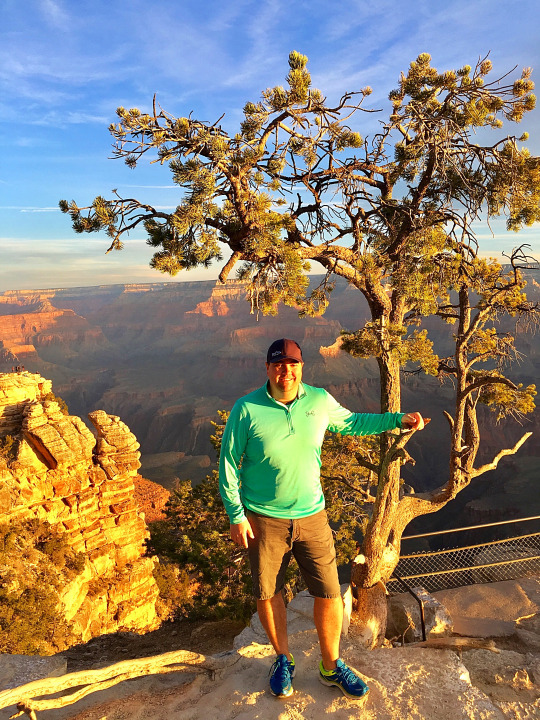

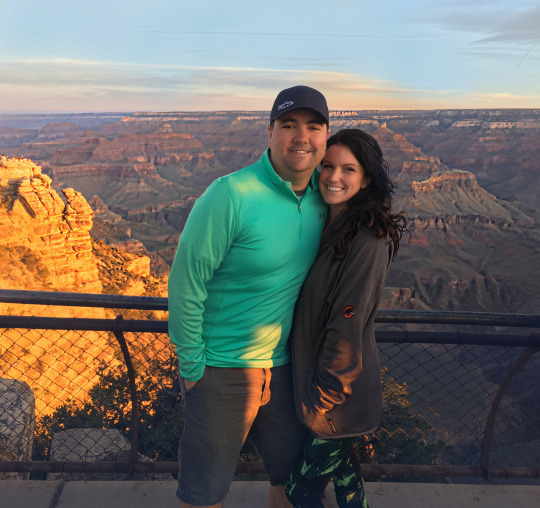
We spent about an hour at various look-outs creating one postcard after another.

With every passing minute, the sun painted a new scene on the tops of the canyon walls and jagged rock formations.
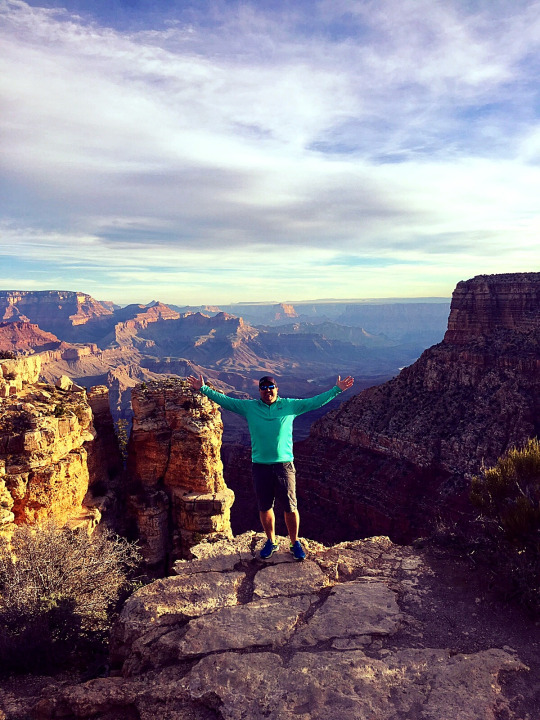
After getting our fill of the canyon, we then continued the roadtrip traveling east on Desert View Drive (the frontage road to the canyon) stopping at several scenic lookouts along the way.
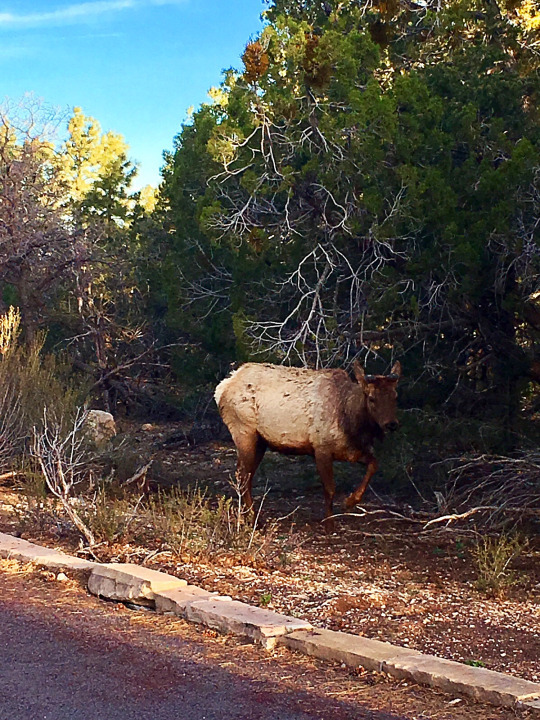
It was at one of these lookouts an elk decided to get up close and personal with us! At another lookout, Dyan decided to jump the safety railing and hike down onto one of the peninsulas that jets out into the canyon.


Another two hours into the desert drive and we finally arrived at Horseshoe Bend. Horsehoe Bend is a geological phenomenon created by a winding river perfectly wrapped around a peninsula of rock that just happens to be a thousand feet deep in a canyon. The result is a teal colored river making a perfect horseshoe bend. Again, I am at a loss for words on how to describe something so magnificent to the eye.

The difference in this scenario is that there was no guard rails on the cliff edge like there had been at the Grand Canyon. I was amazed at the tourists’ lack of caution. The kids running around and teens dangling their legs over the edge were enough to send me into a mini panic attack. So when Dyan wanted to get closer for pictures, I was not a happy camper.

We had a quick lunch in the Utah/Arizona border town of Page, before beginning the 3.5 hour drive back to Sedona. The drive was uneventful compared to our pitch black morning commute, but the sun was out and it had warmed enough (80 degrees) to put the top down.
About 30 minutes outside of Sedona, Dyan hatched a new plan. She had seen ATV rentals when we drove through Sedona the previous day, and wanted to rent an ATV to tour the back country. Forty five minutes later, we were strapped into an indestructible-mud-rocket that could take hairpin turns at 55mph. JACKPOT! Funny enough, you have to drive this through town (among traffic) in order to get to the back country. Once in the back country, we were free to explore. And explore we did!
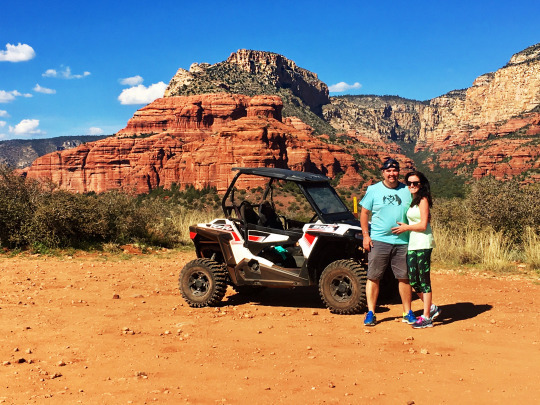
When we picked up the ATV, they asked us if we wanted a scenic route, or a fun route. We chose FUN! Our route took us though the Ancient Hokanani Ruins.
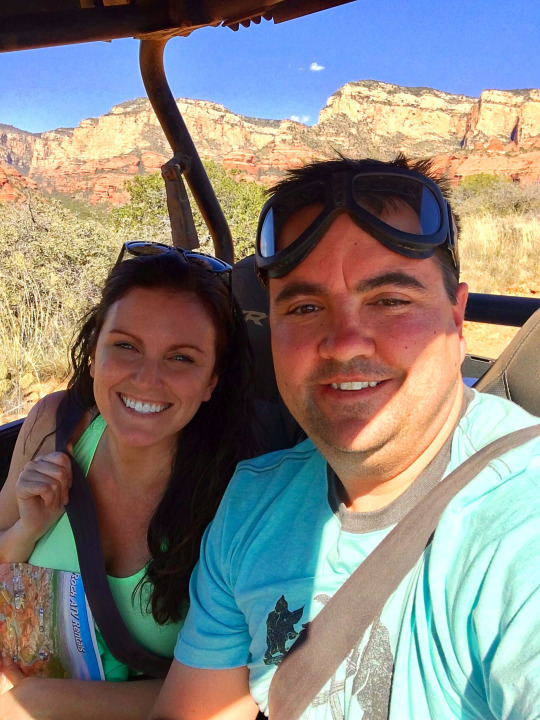
We didn’t stop to see what the ruins looked like because driving that little hell-machine was too much fun. We blazed down the dirt straightaways at nearly 60mph. We climbed rock steps and crossed rocky creeks. We went airborn on jumps and two-wheeled uneven climbs. It was everything you could imagine an off-road course being. The only downside was the insane amount of dust that gets kicked up. At times, it was almost like driving through a thick fog, and we had a couple of close calls with some oncoming traffic! Crazy how an unplanned activity ended up being one of the highlights of the trip. When we finished, we were both covered in red dust from head to toe.

We needed a shower bad, but a cold beer even worse. It was now 4:00 and happy hour was going on at the Old Sedona Bar and Grill which was across the street from the ATV rental. As we cooled off from the heat, we watched Kansas destroy Michigan State 90-70, punching their ticket to the Sweet 16. It was also during this brief bit of downtime that Dyan decided it would be a great idea to do a sunset hike to Devil’s Bridge. She assured me it was 2 miles roundtrip….
At 4:30, we arrived at Devil’s Bridge trailhead with a couple of beers in the tank.
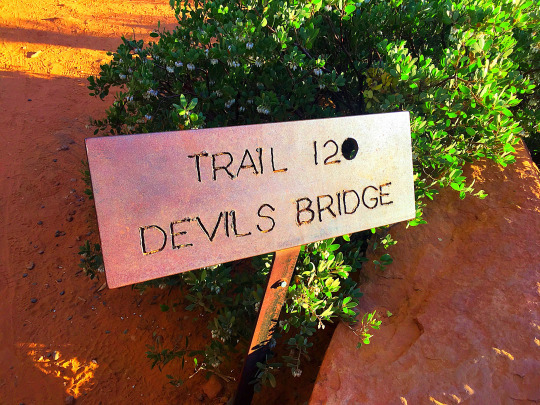
About a mile into the hike, I began realizing we weren’t even close to Devil’s. That is when Dyan let the truth be told. The hike is actually about 5 total miles. She knew if she told me it was 5 that I would have never agreed to go on the hike. So, there we were, in the middle of a desert forest dressed for the beach and tipsy as a tugboat. We were too far into the hike to just turnaround, but far enough away from the bridge that solicited some unpleasantries under my breath. So we hiked further. The easy hike turned into a moderate hike with akward steps. The moderate hike turned into full blown mountain expedition as we neared Devil’s Bridge. Glad I have two good knees. Oh wait, nevermind…
I will say, the view from the top of Devil’s is pretty spectacular, and is well worth the challenging hike to get there. JACKPOT!.
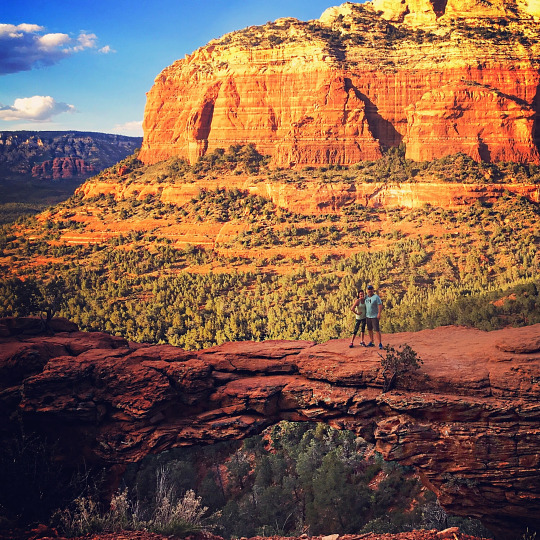
The red and gold mountains in the distance provide the perfect backdrop to the bridge carved into the rocks. Dyan and I posed for a few pics before heading back down the mountain.
I had feared we’d get caught out in the dark and be unprepared and cold, but my sidekick assured me the entire hike that we would get back to the car in time. And she was right. We walked up to the car right at sunset.
We were beat. We spent 9 hours on the road, 2 hours in an ATV and 2 hours hiking. All we wanted was a relaxing evening on our balcony overlooking the Red Rock mountains of Sedona . Unfortunately, Corbin at the Hilton had other plans for us. Around 6:30 we arrived at the hotel and Dyan stepped into the lobby to check-in while I fetched the bags from the car. As I approached the lobby entrance, Dyan met me and said, “You are never going to believe this. They don’t have our reservation for tonight.” I was floored. Time for a pow wow with management. We provided our confirmation number to the manager and she indicated she did not know what happened, but she no longer had our room available. We explained the situation to her that Corbin and his manager had confirmed us for the upgraded room a day earlier, so we couldn’t understand how they did not have our room. After all, it was pre-paid! The Hilton apologized profusely, and said they were overbooked and there was nothing they could do since all the premium rooms were already taken. They put us in a standard room and provided a $100 dinner voucher as a consolation. We were really ticked off, because we had spent $425 for the premium room.
We had dinner in the hotel restaurant, which was really good, but the service was awful. Our server Pauli was completely absent the entire meal. The manager, chef and host did all of the work at our table. After dinner, we made a quick stop to the Jacuzzi, but it was crowded with guests, so we didn’t last long. We needed sleep.
On Monday morning, we got out of the Hilton as soon as we could and headed south toward Phoenix to begin our pool day at the Westin Kierland Resort. About 30 minutes into the drive, Dyan and I both noticed a casino along the interstate. I sensed a pit stop coming.....
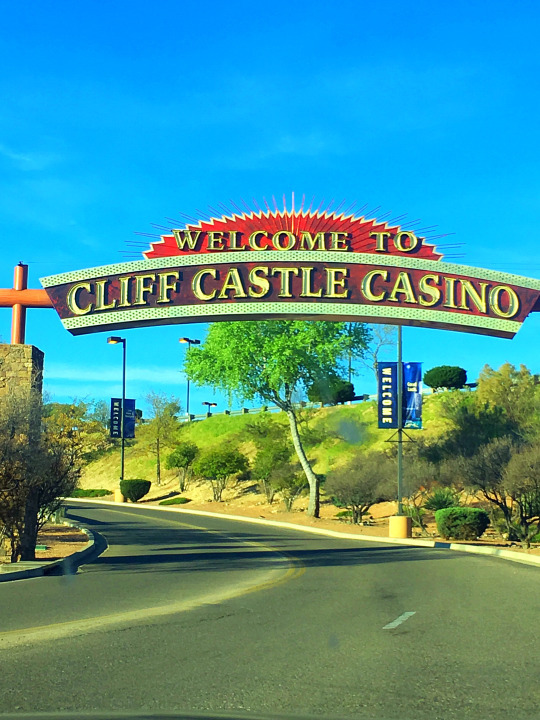
Cliff Castle Casino was not very large, but they had the two things Dyan loves. Buffalo Stampede and a High Stakes Slots room! After losing most of her daily allowance I suggested we get VIP Club cards to the casino. Each card gets a lottery chance at free slots play. I won $5 free (which I lost to the Buffalos immediately) and Dyan won $10. With her remaining money and VIP $, Dyan ventured into the High Stakes area where she sat down at the African Diamond machine. She was losing bad and was down to $6 left of her VIP money. That’s when she max bet and hit the free spins bonus. What came next was a game changer. On the first 9 (out of 10) free spins, she won NOTHING. On her 10th and final spin, she hit a JACKPOT and won $340!! We cashed out immediately and continued the trek to Phoenix.
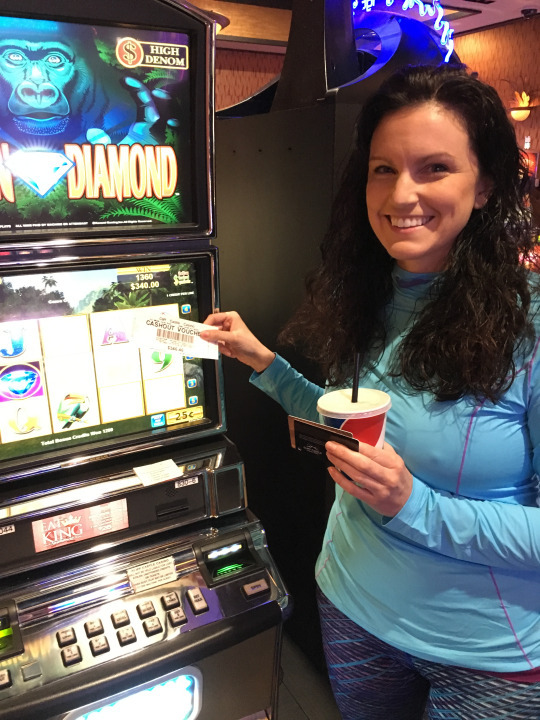
We LOVE SPG properties, especially Westin branded hotels. They treat us SO well, and constantly give us upgrades. We arrived at the Kierland resort around 10AM. They indicated we were being upgraded to a large suite overlooking the mountains to the east of Scotsdale.

The room was not ready yet, but they offered us complimentary access to the guest lounge on the 9th floor to enjoy sodas, hors d’oeuvres and snacks while we waited. They also provided us with complementary access to the spa/locker rooms so that we could change and use the pool facilities for the day. They were absolutely accommodating.

The Westin pool did not leave much to be desired. There is a family pool, complete with lazy river and water slides which we spent some time at, however, our favorite amenity was the adult pool, where children under the age of 18 were not allowed. For 4 hours, we alternated between the pool and the sun chairs as we sipped Pina and Key Lime Coladas. Around 3, we checked into the room and got ready for the evening.
We headed toward Old Scottsdale for dinner, but neither of us were all that hungry…so, we started looking for things to do in the area. Well, well, well, there was a casino just a few miles away! Dyan looked at me and said, “It is your call, but I feel lucky.” I can’t say no to that, can I? We ventured into the casino, and immediately spotted two machines – Willy Wonka and you guessed it, Buffalos! Unfortunately both were occupied. We played lightly at several machines as we kept a close eye on our honey holes. About 30 minutes into gambling, one of the Willy Wonka’s opened up and Dyan sat down immediately. Within 5 minutes, Dyan produced a free spin bonus on a big bet. The Oompa Loompa’s were in her favor as they gave her wilds across the board. It was a JACKPOT win dishing out $308. A sign came up on the machine that said “Call Attendant” for a hand pay. The attendant was there instantaneously and paid Dyan for the win. It was also interesting that she shut the machine down and restarted it. She said they restart the machine after every jackpot win. Before leaving she made a point to say this Wonka machine had hit jackpot wins all day long! My guess is that was a canned statement trying to get gamblers to keep feeding the machine. Dyan was not hooked by the attendant’s statement and said, it’s time for a steak dinner!

We headed back toward the hotel and decided on Capitol Grill for dinner. Dyan had the filet, I had the aged NY Strip, and we shared mashed potatoes. We sat alone out on the patio for nearly two hours enjoying amazing food, each other’s company and the perfect evening. JACKPOT!
Our final day in Phoenix started off with a couple’s Rollerssage at the Agave Spa located inside the resort. The rollerssage was amazing. The spa’s description was spot on: The massage combines the deep healing power of a Swedish massage with radiating heat using a roll of smooth semiprecious stones to create relaxation and relieve tight muscles. After the massage, we utilized the spa facilities which included hottubs, saunas and steam rooms among other things.
After the spa, we laid out at the adult pool all day sipping frozen cocktails and snacking on chips and salsa. Every day we were in Phoenix, the temperature was well over 90 degrees and all sunshine. It was the most perfect spring break weather we could have asked for. Phoenix set records for high temps on multiple days. Our timing of this vacation and the extreme heat was perfect. The week before we arrived, Phoenix had temps in the 70’s, and two days after we left, it was only in the 60’s, with rain. We were so fortunate to have the weather we did.
Around 1:00, we packed up the Stang and headed to the airport. The amazing luck we had on this trip just kept rolling for us. As we drove into the car rental return, a young man looked over the car and asked us how it handled. I got pretty chatty with him telling him how awesome the car was, but did point out that the previous driver smoked heavily in the car (I didn’t want Alamo to think we were smoking in the car). As I was talking to the Alamo representative, Dyan was checking under the seats to see if we had left anything in the car. Dyan popped up holding a half package of cigarettes indicating they must have been left by the previous driver. The rep looked at the package and began profusely apologizing saying he was going to take care of the problem. He handed me a receipt for the rental that showed he took $100 off of the car rental! I told him it was not necessary and that we already got a great deal on the car. He looked at me and said, “Smoking is not allowed in our cars and I am sorry you had to deal with the smell. That is not how we do business, so hopefully this credit makes things better.” Wow! JACKPOT!
We shuttled over to the airport and checked in for what was sure to be a long flight home. Flights home are never a happy time!
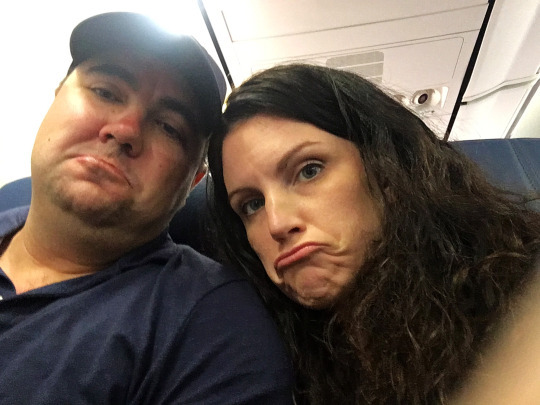
Fortunately for me, we were on a brand new 757 aircraft which had the same entertainment package as our other flight. Dyan and I watched Office Holiday Party for the first couple of hours, and I geeked out again on the flight tracker software the rest of the way home.
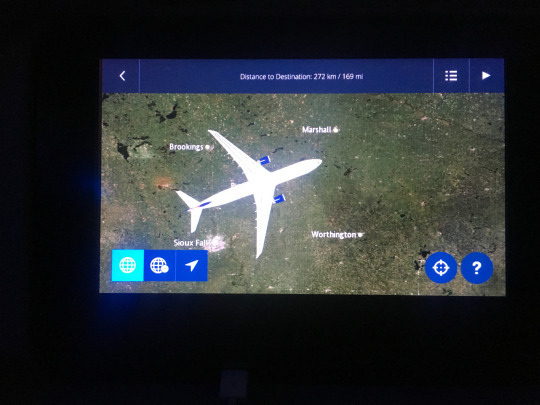
I was even able to spot our Apple Valley neighborhood on our approach into MSP.
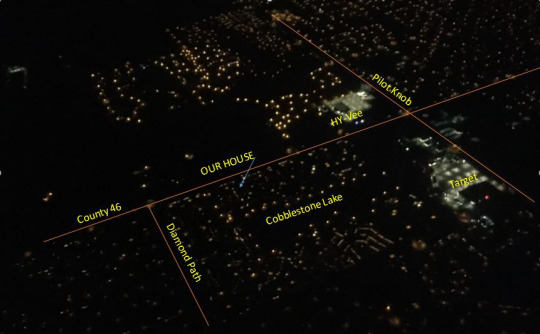
A couple days after getting back home, I received a survey from Adestinn on how I would rate my travel experience booking through them. I provided some honest feedback about the disappointment we had at the Oak Creek Hilton. I wasn’t really expecting anything to come from that feedback, but Adestinn circled back with me in the following week to let me know that they and the Hilton property were very sorry for the experience Dyan and I had at their hotel. Along with an apology, they offered a full refund ($425) for our stay because they were not able to give us the room we had paid for. Wow again! I feel like I won the jackpot for all the credits we received - first Alamo, and now this!
All in all, this trip was amazing at every single turn. While basking in the sun at Westin, Dyan and I were trying to rank all the trips we have taken. It was a consensus that Spring Break 2017 in Arizona at least has a share of the top spot, if not holding it outright! JACKPOT!
0 notes